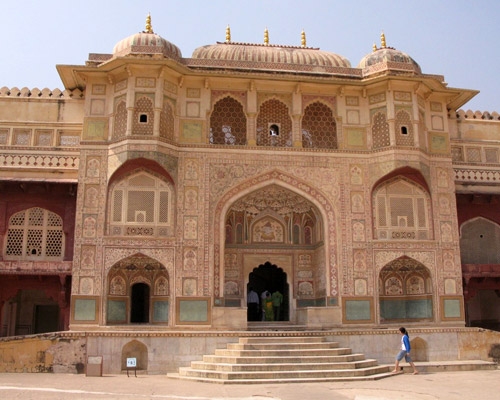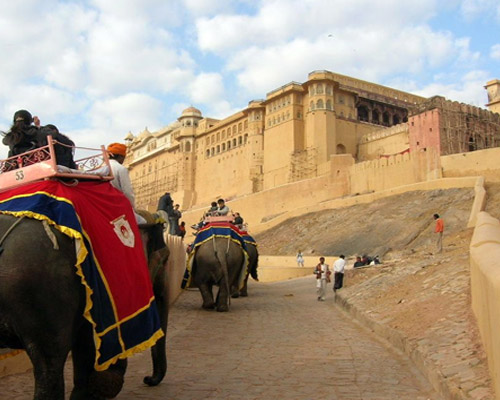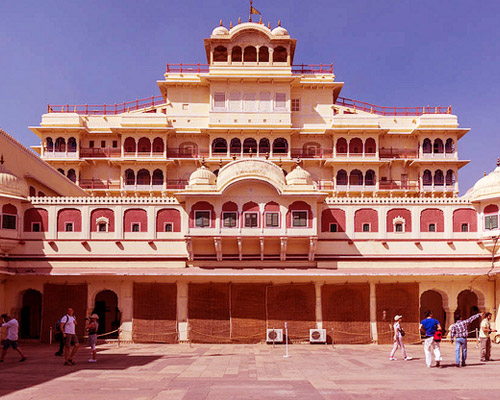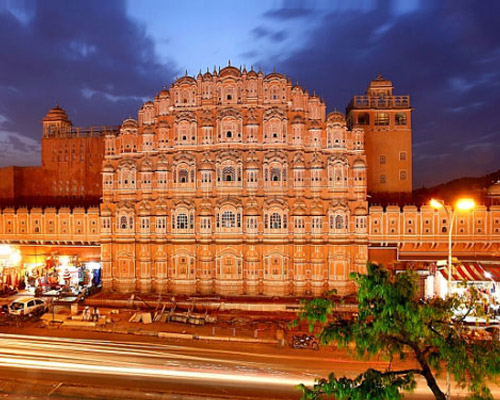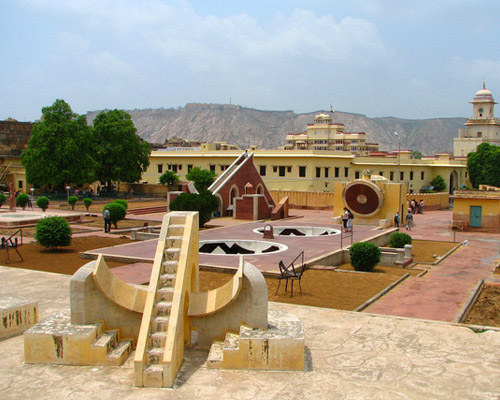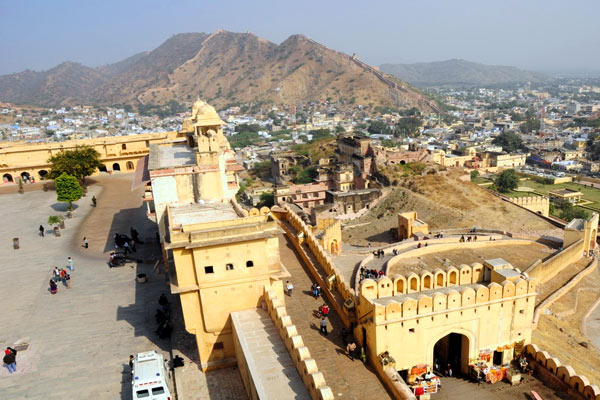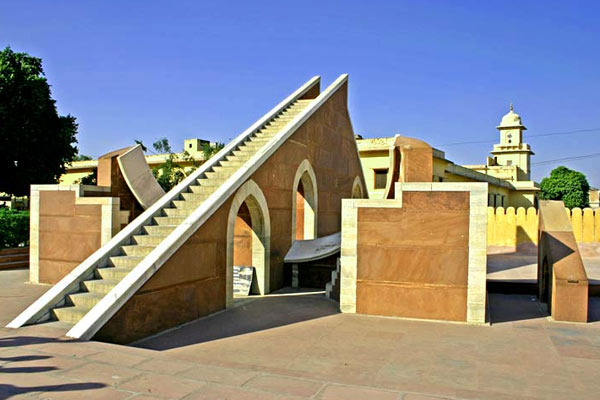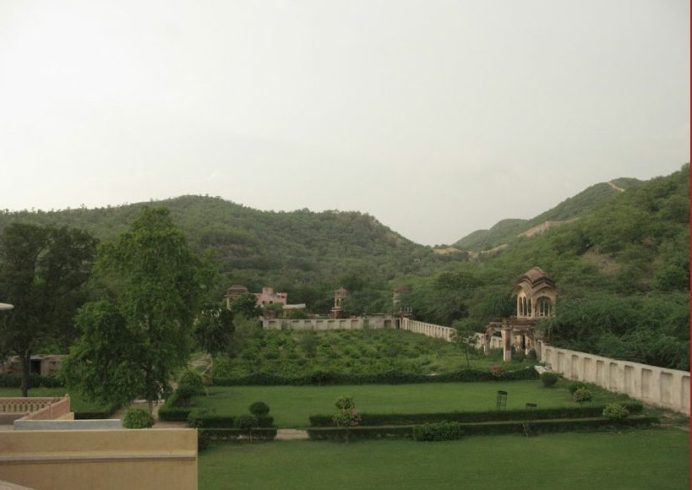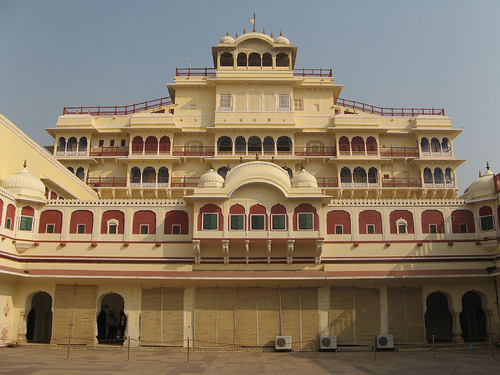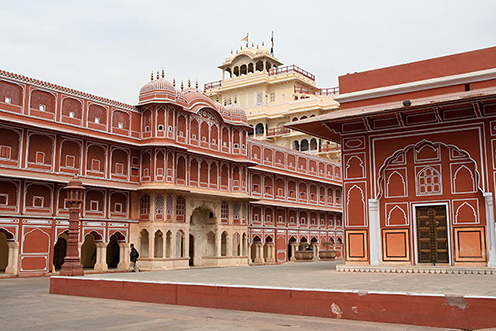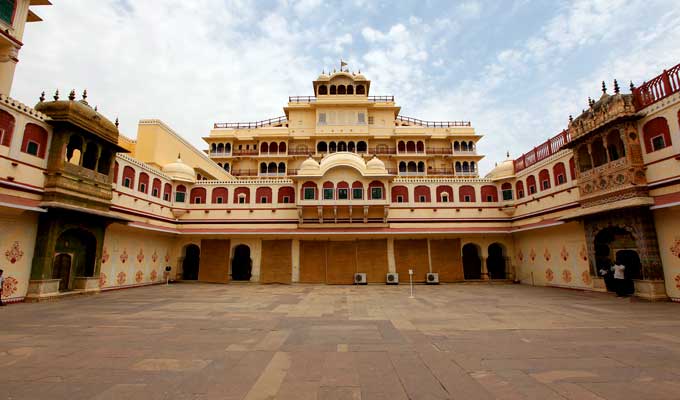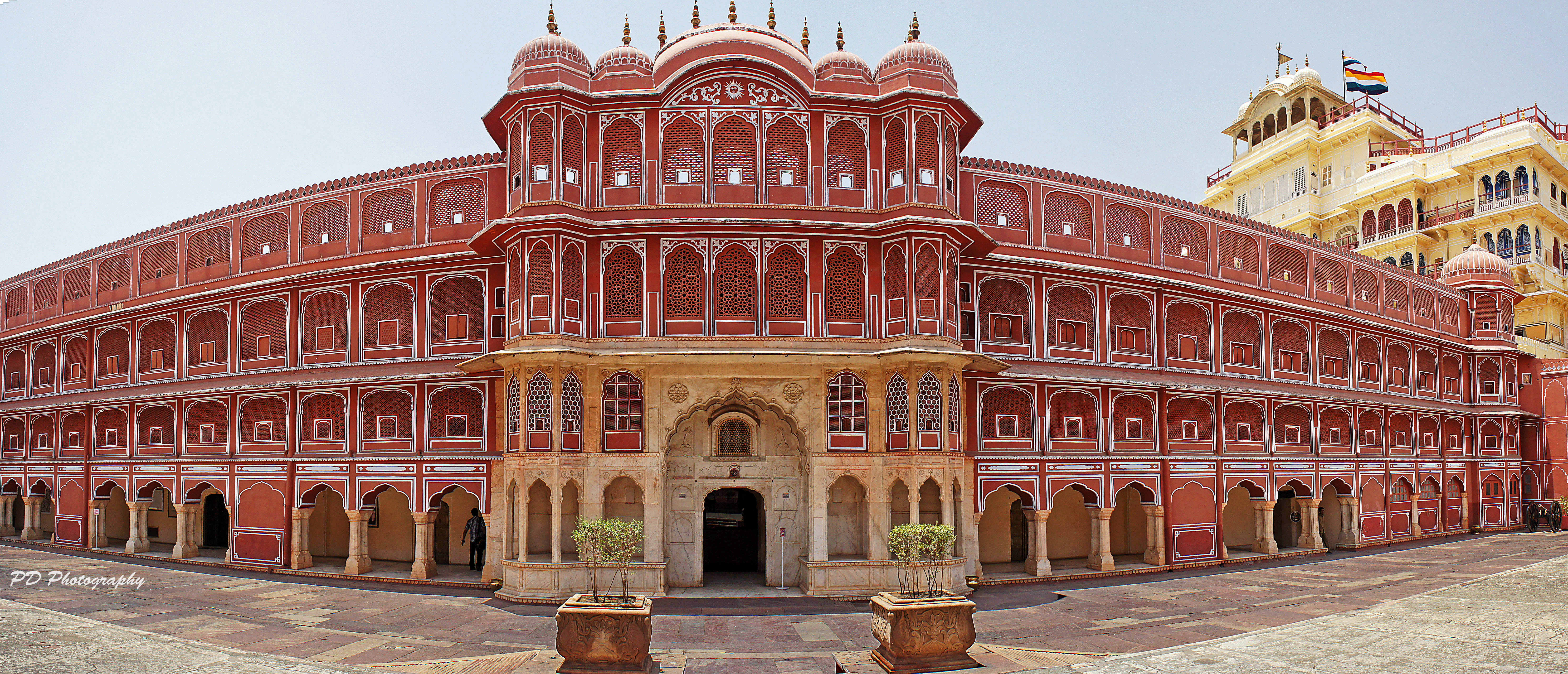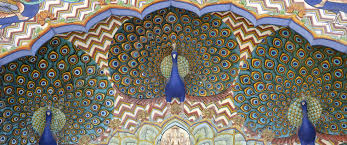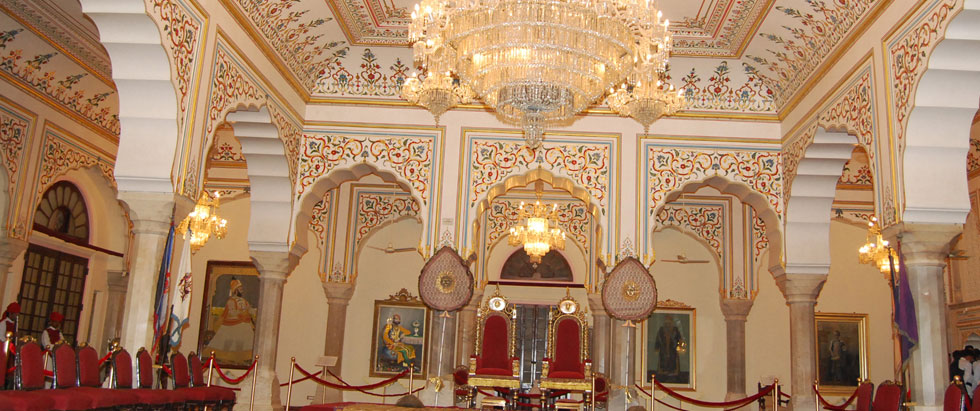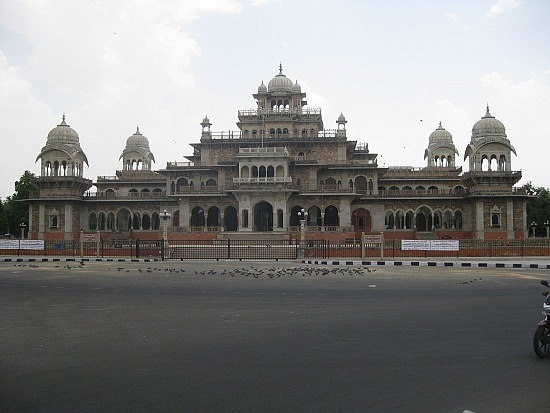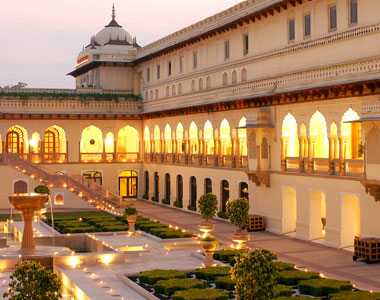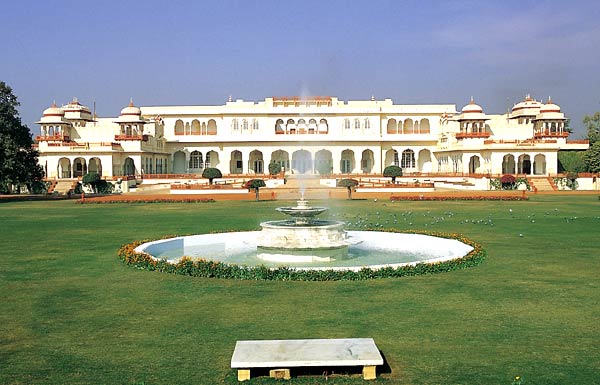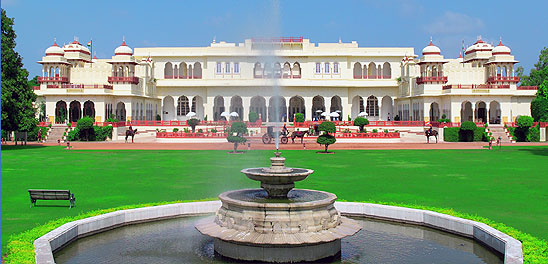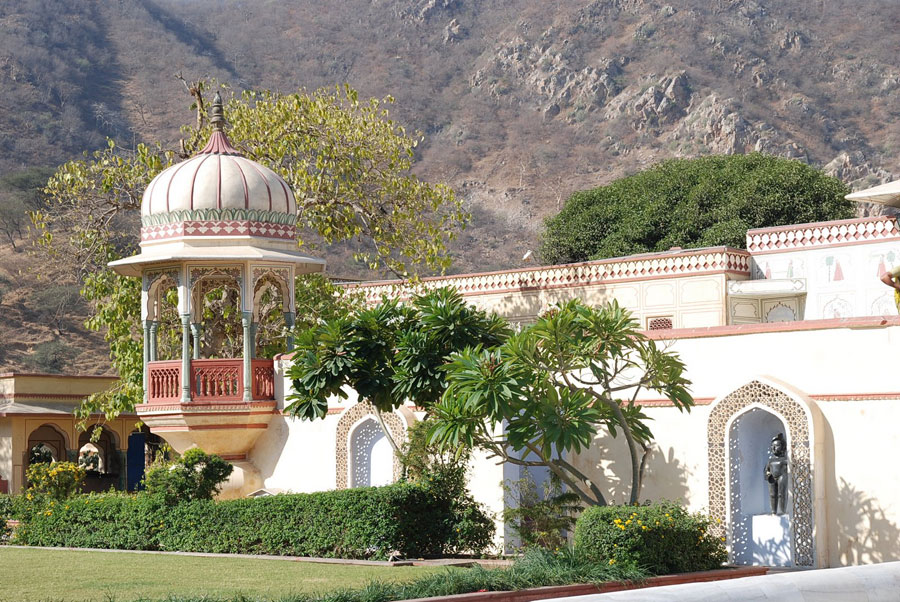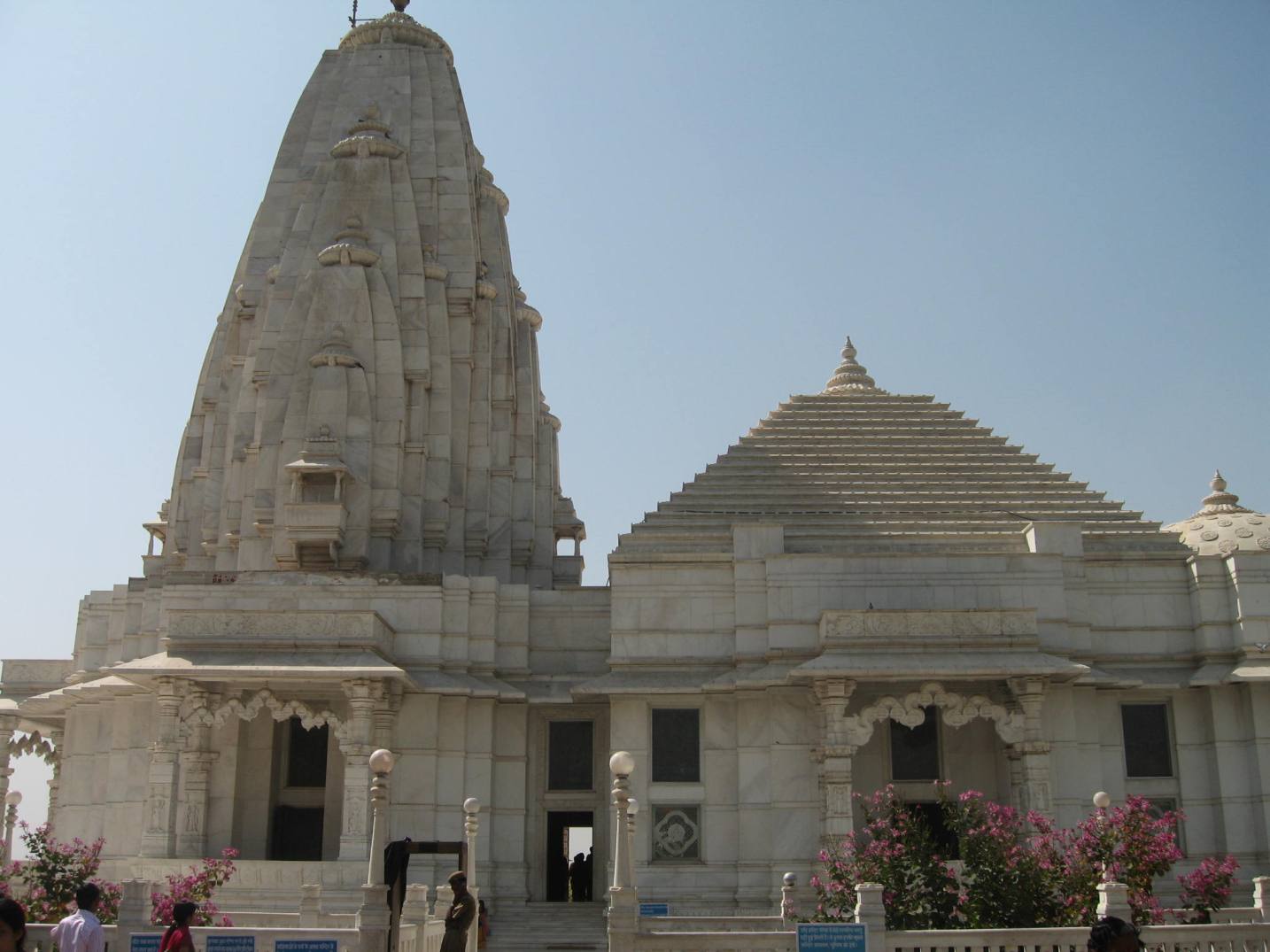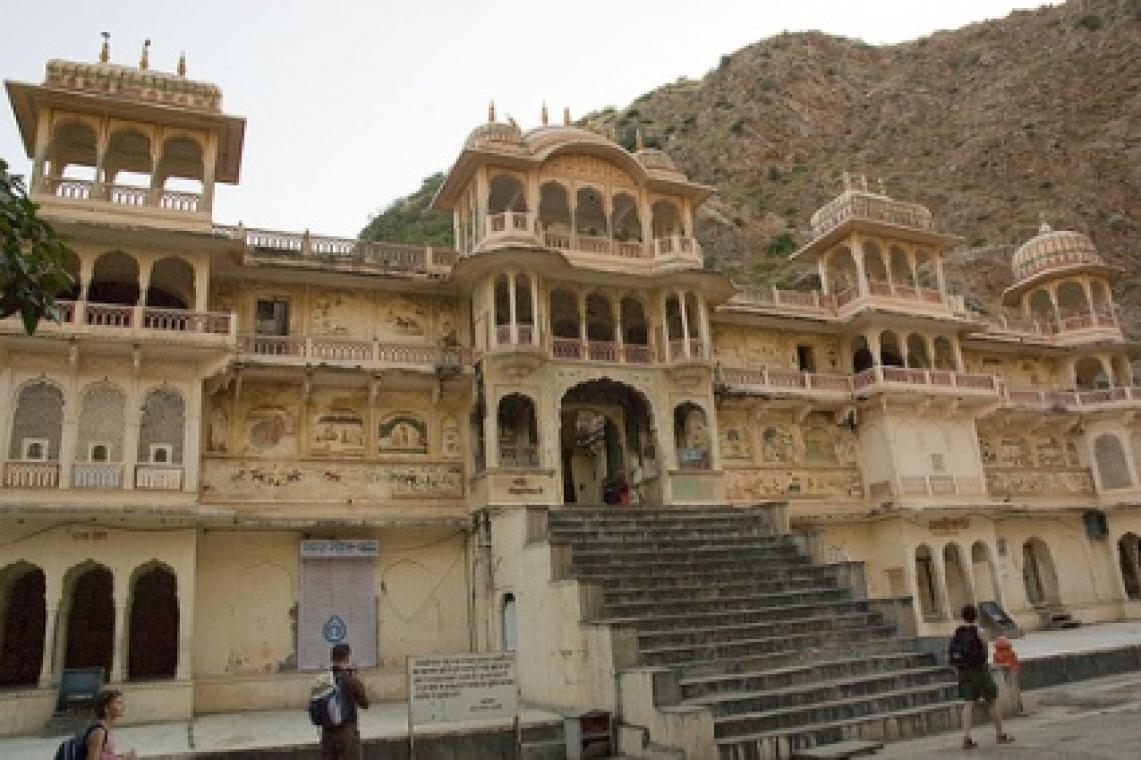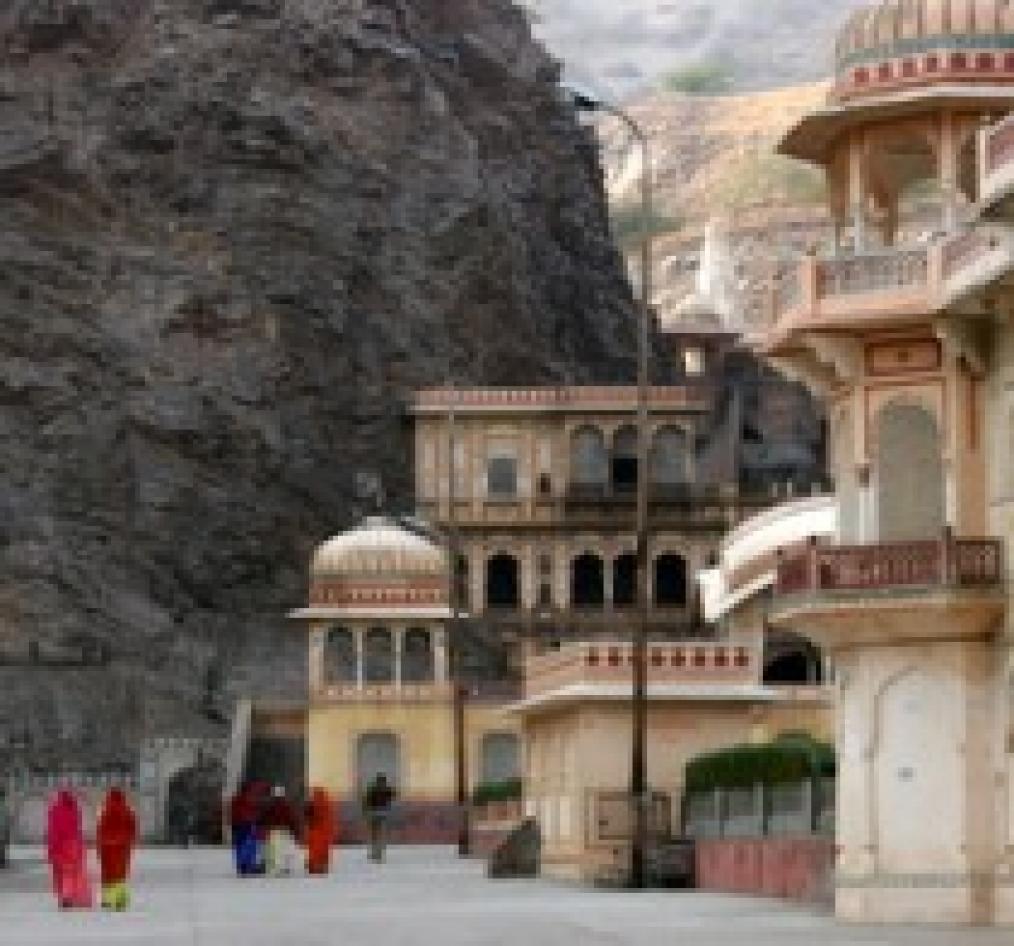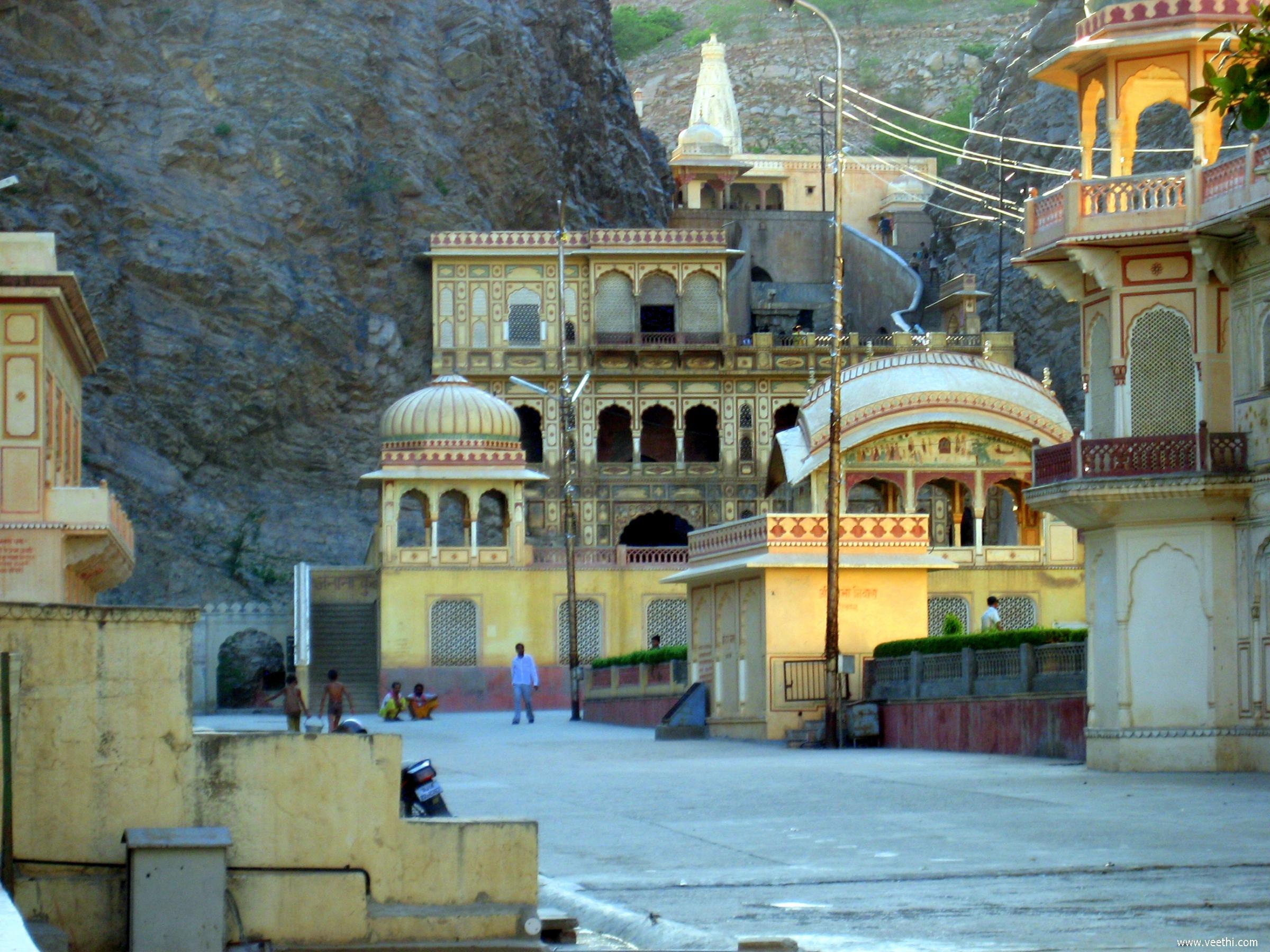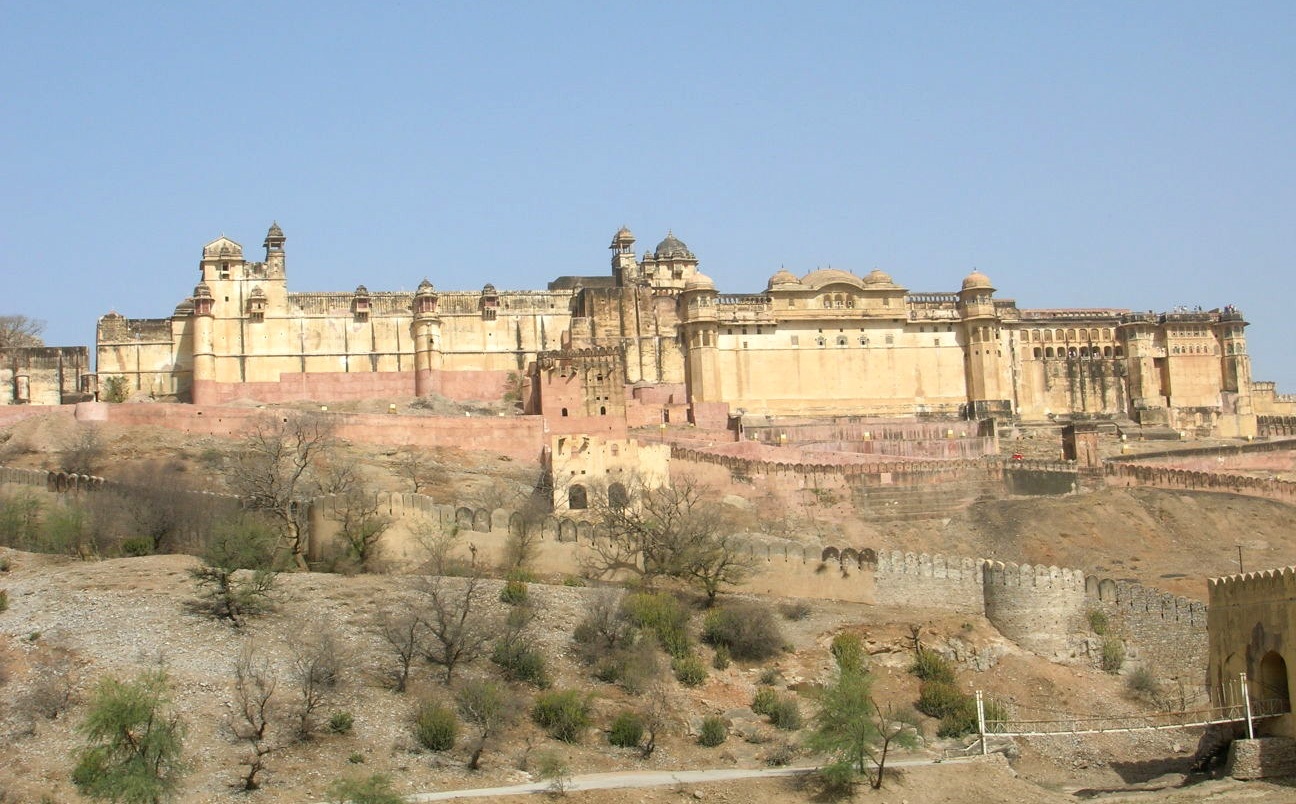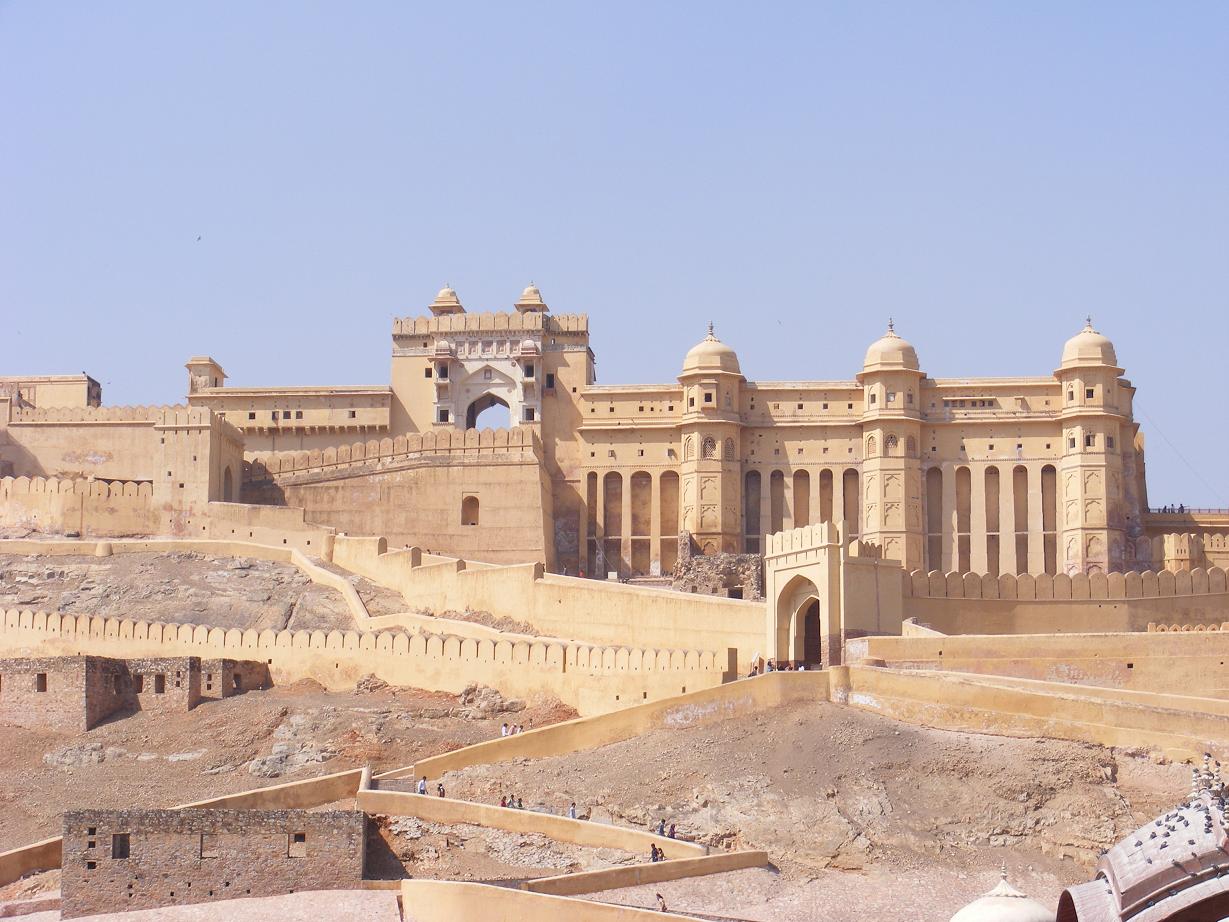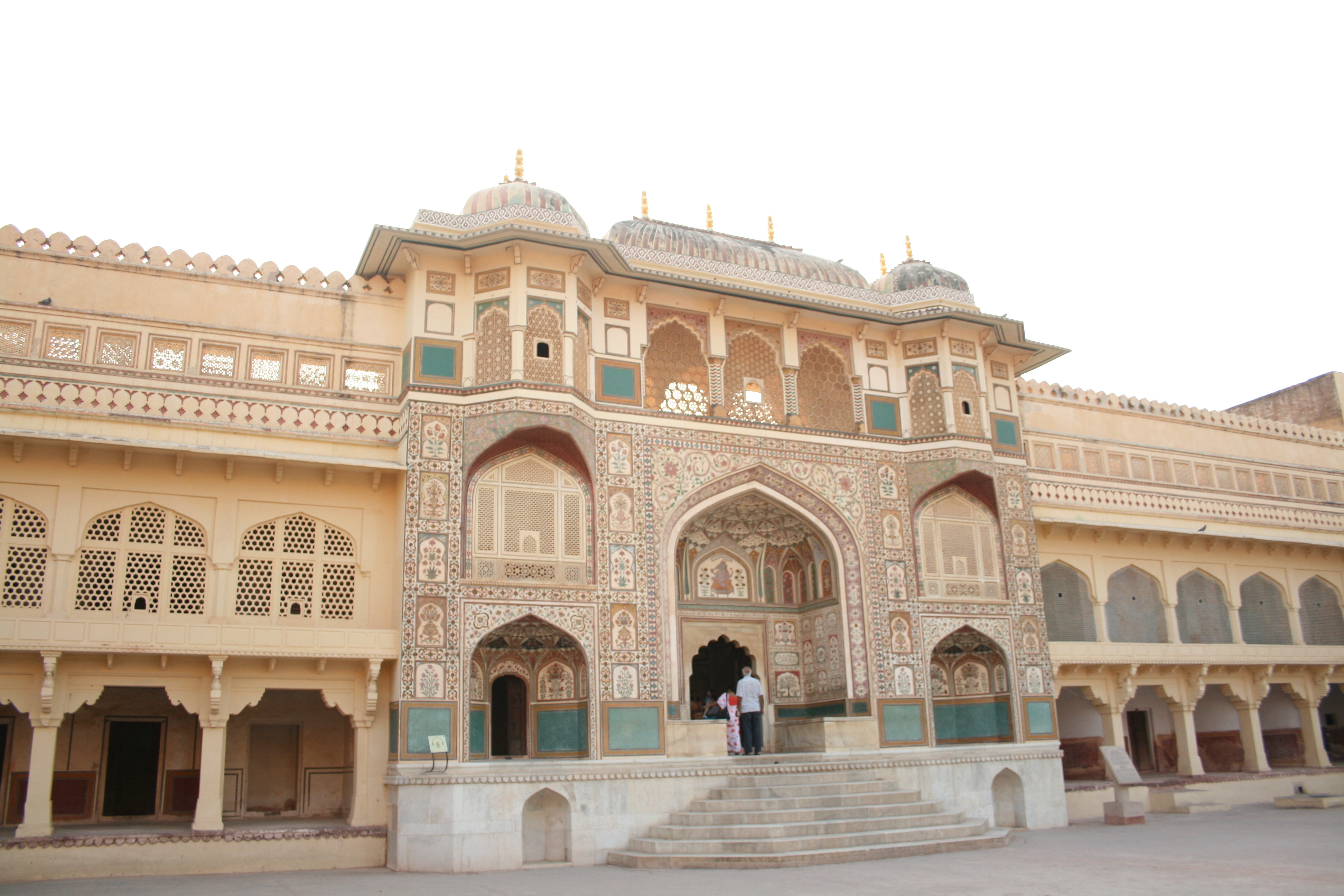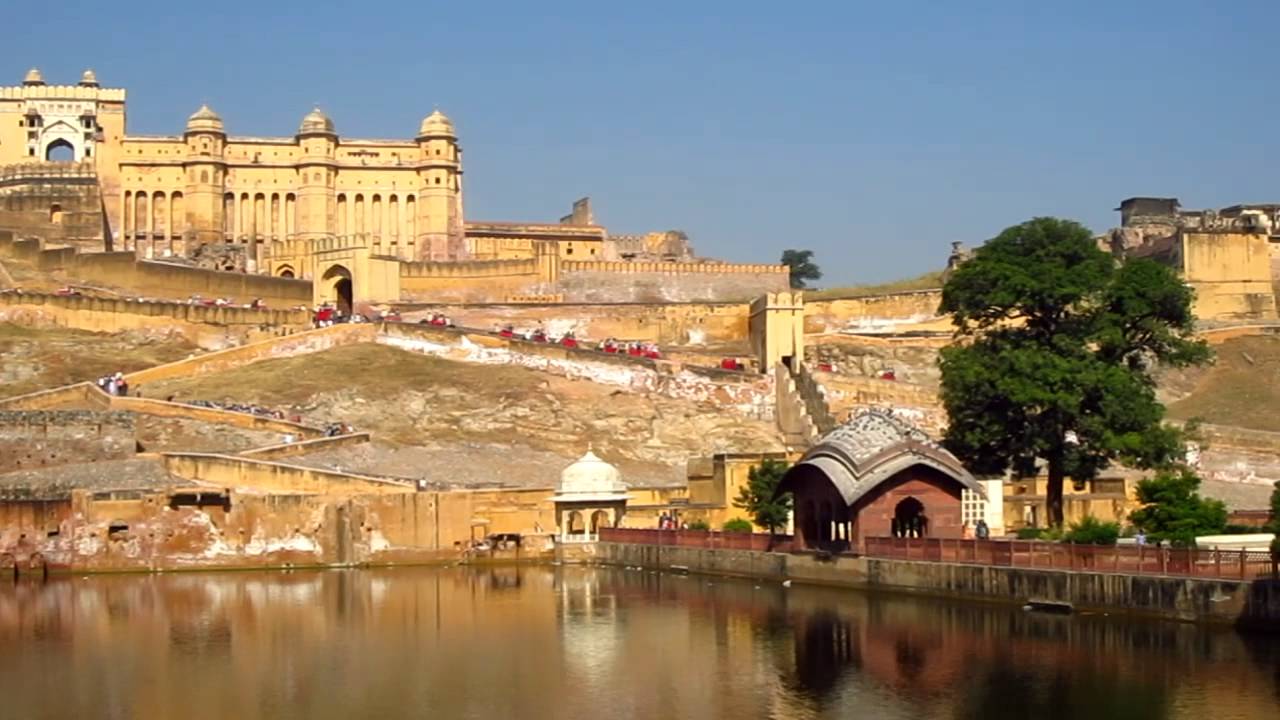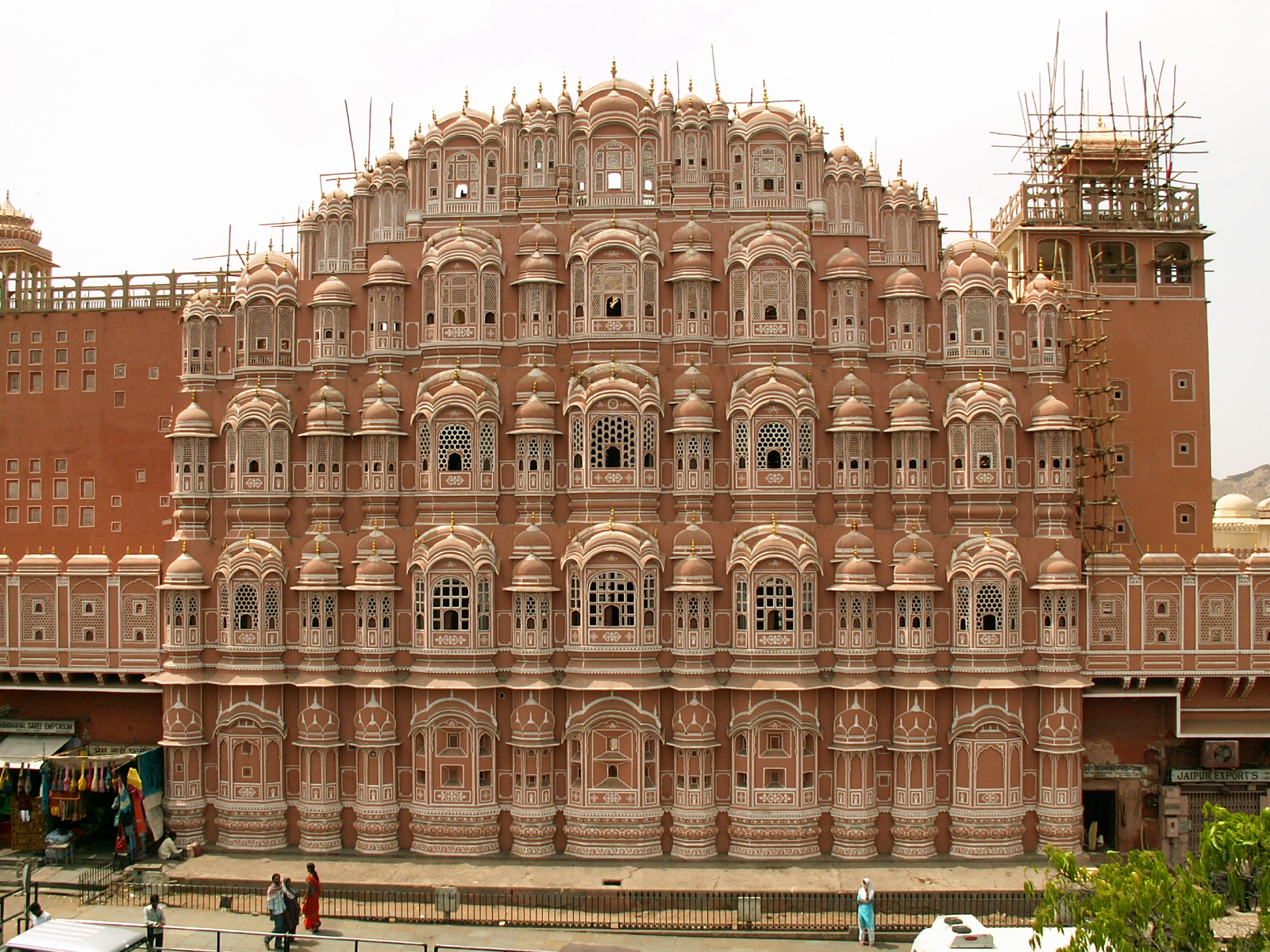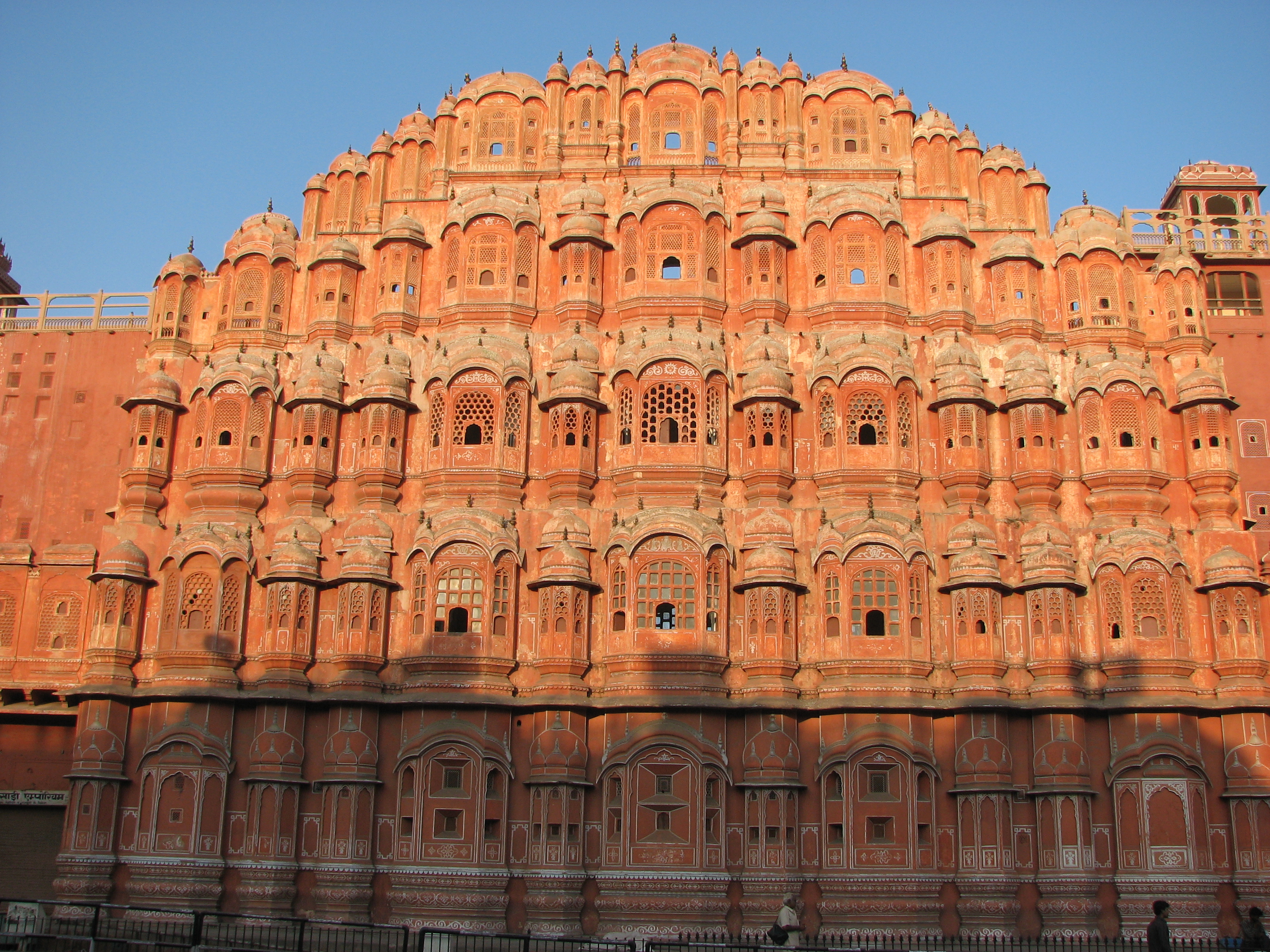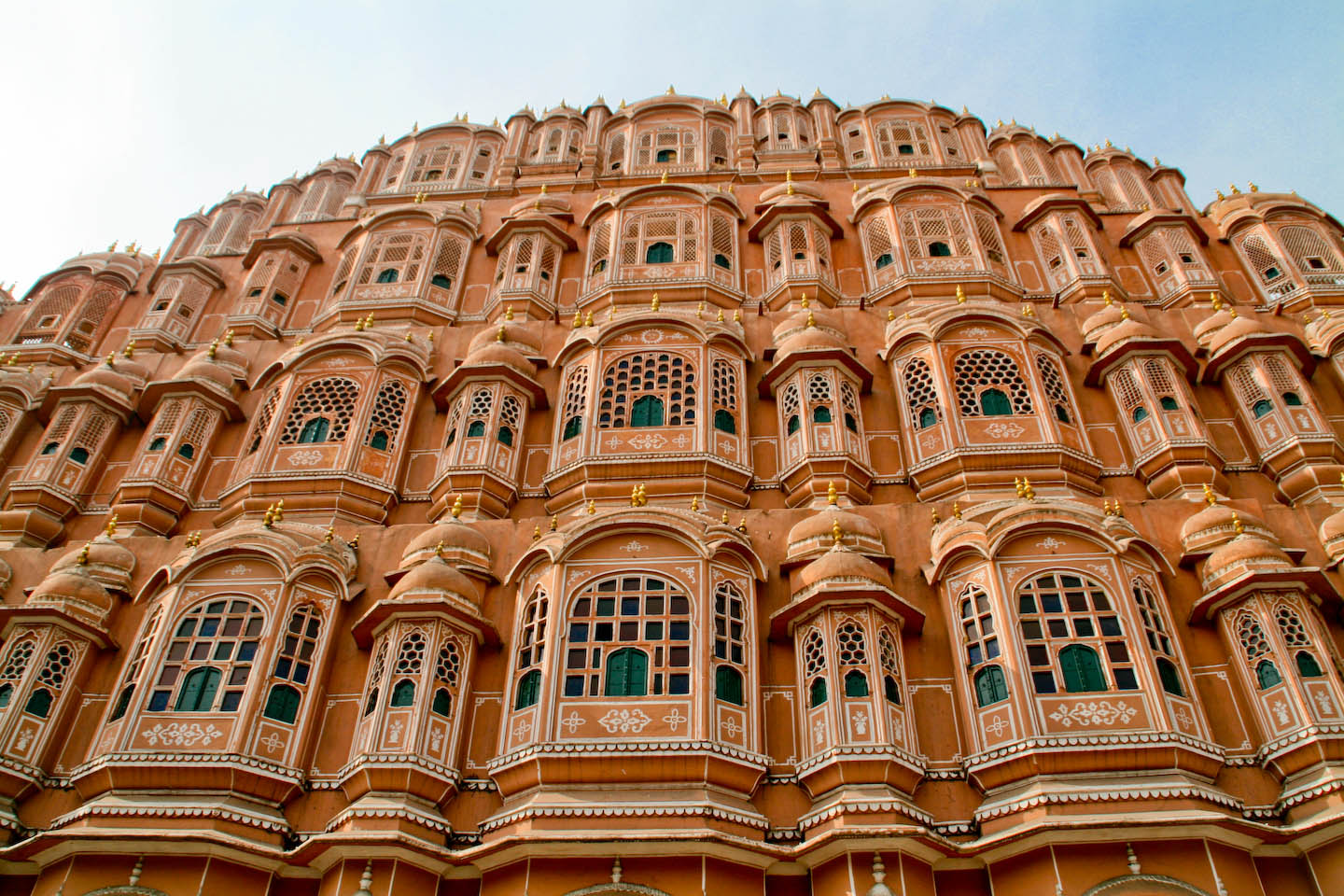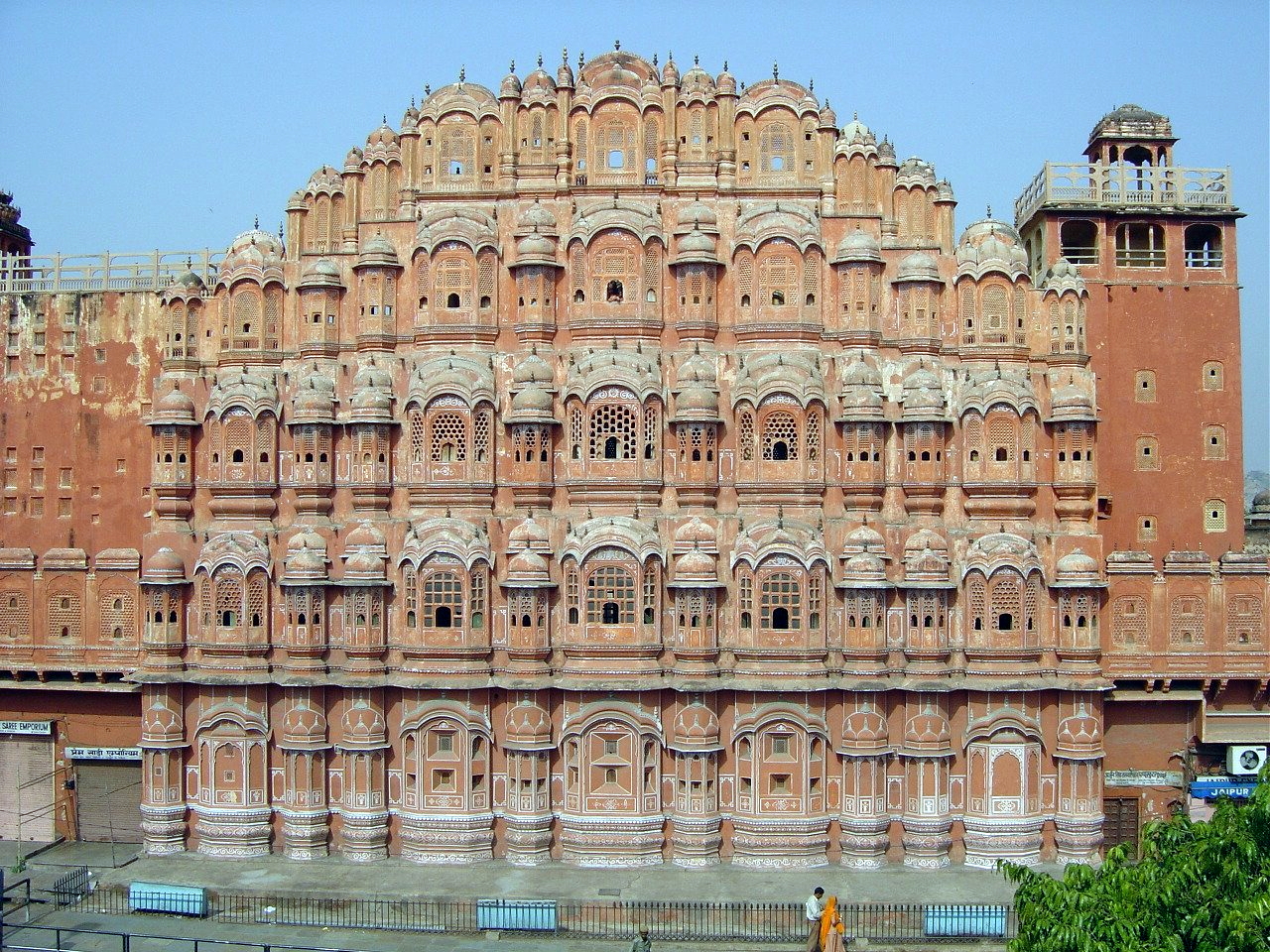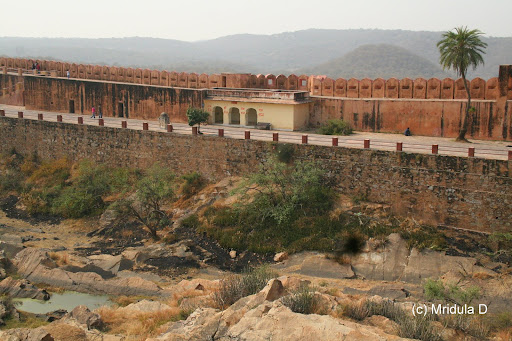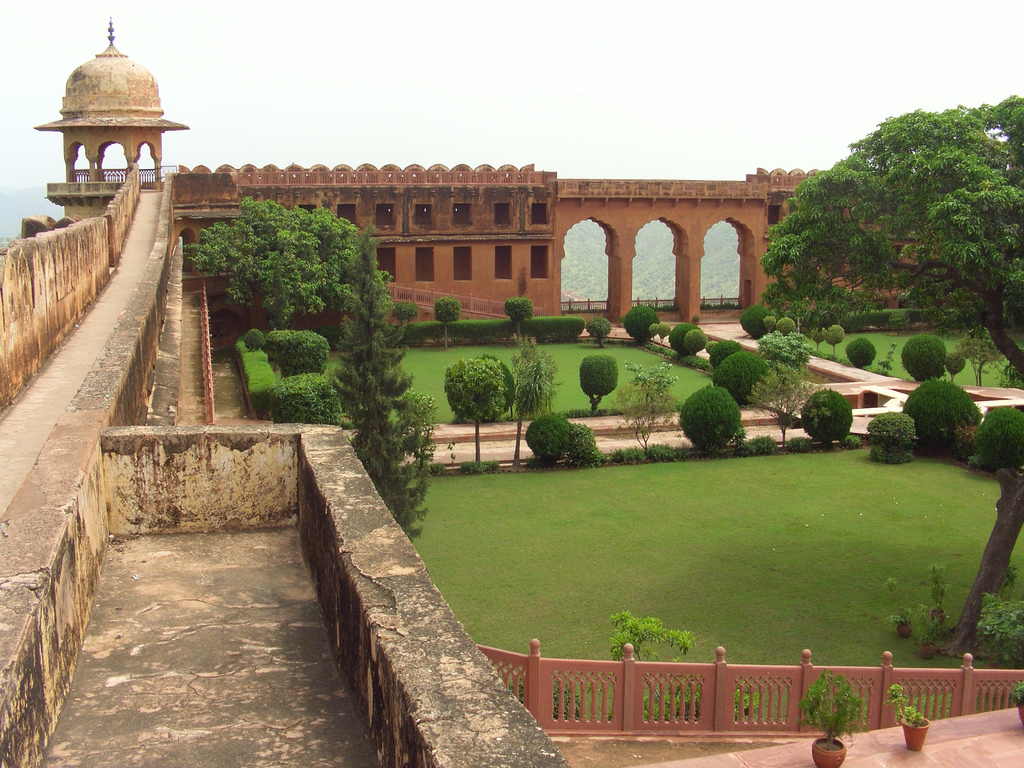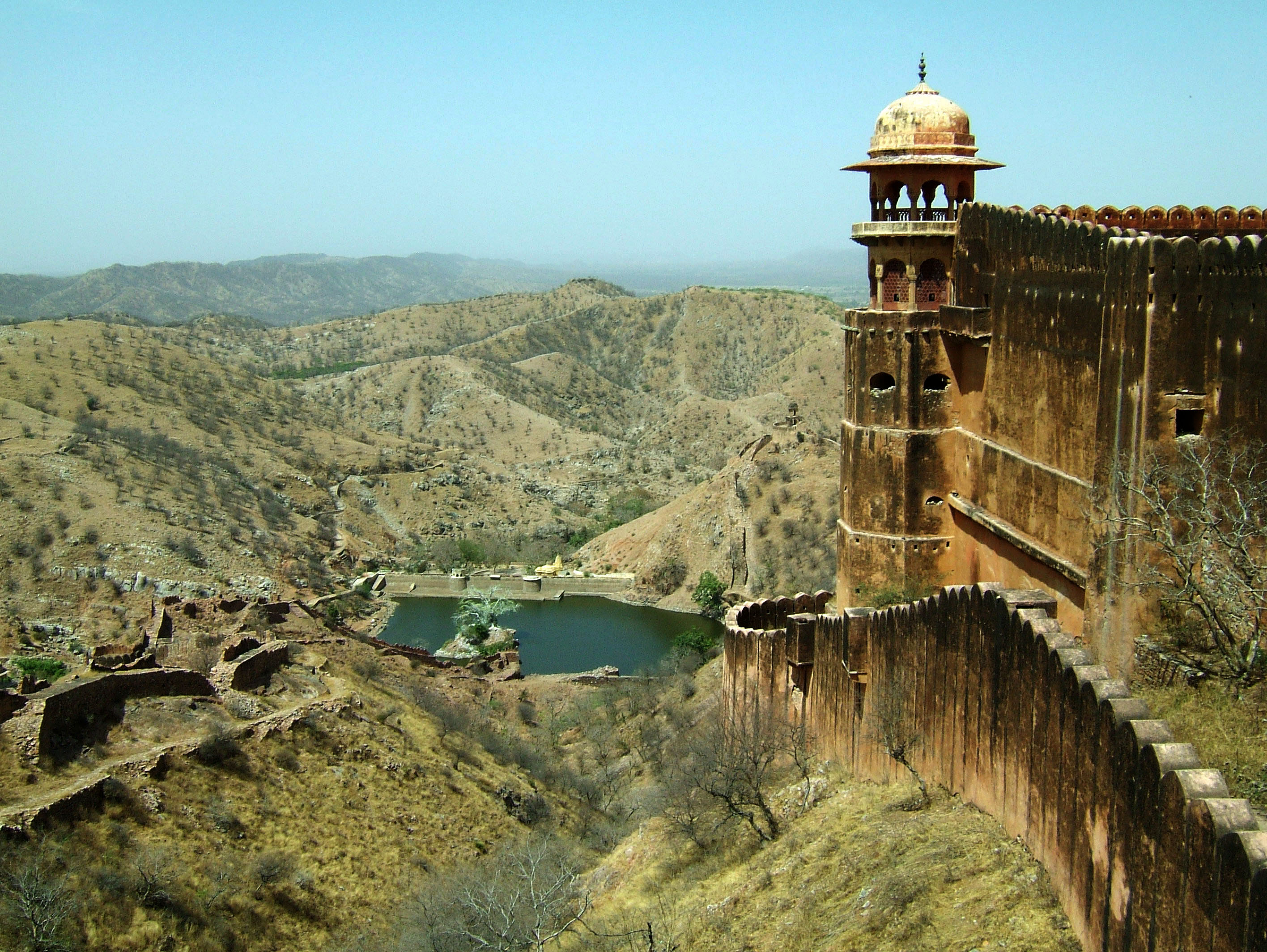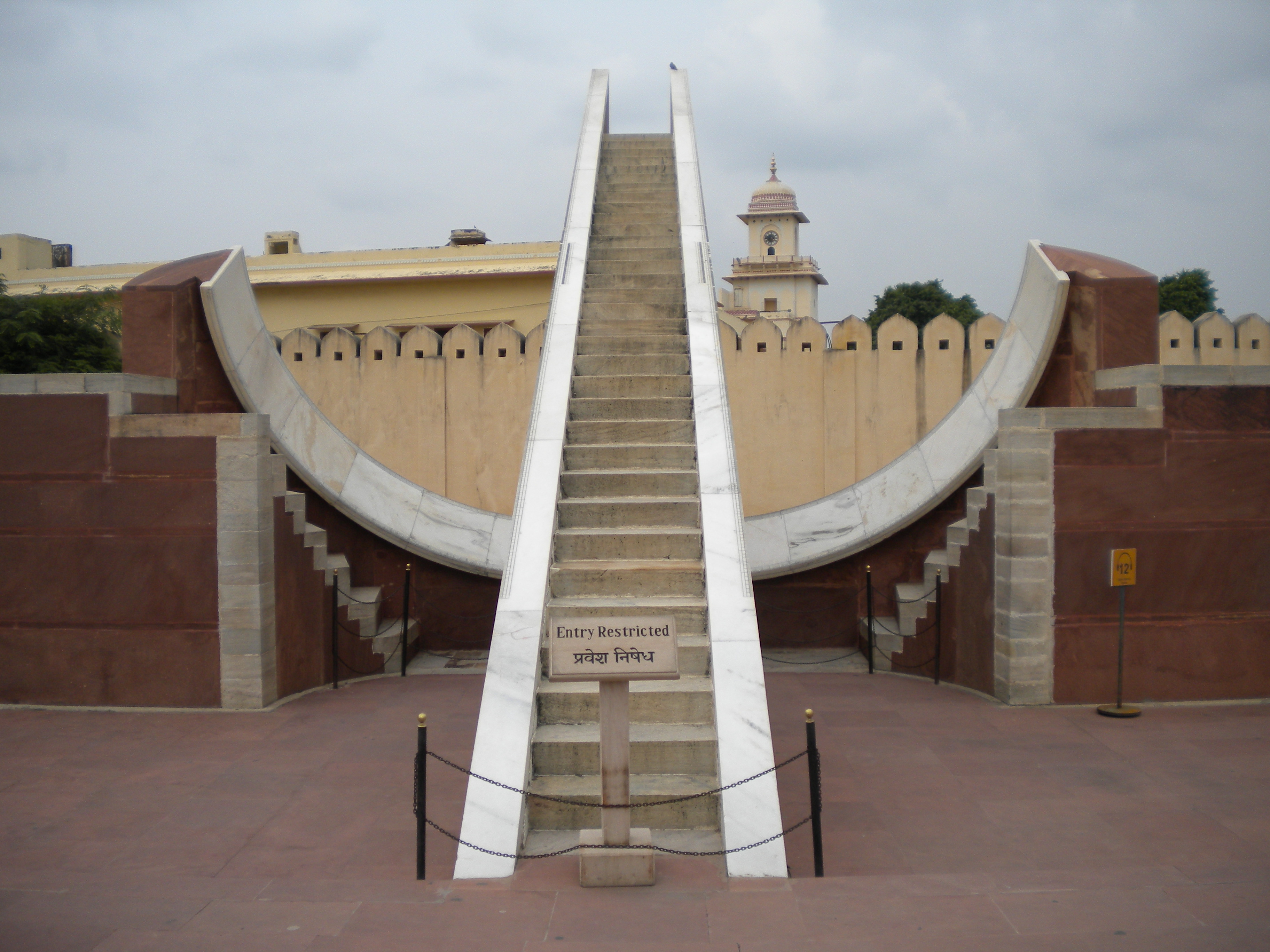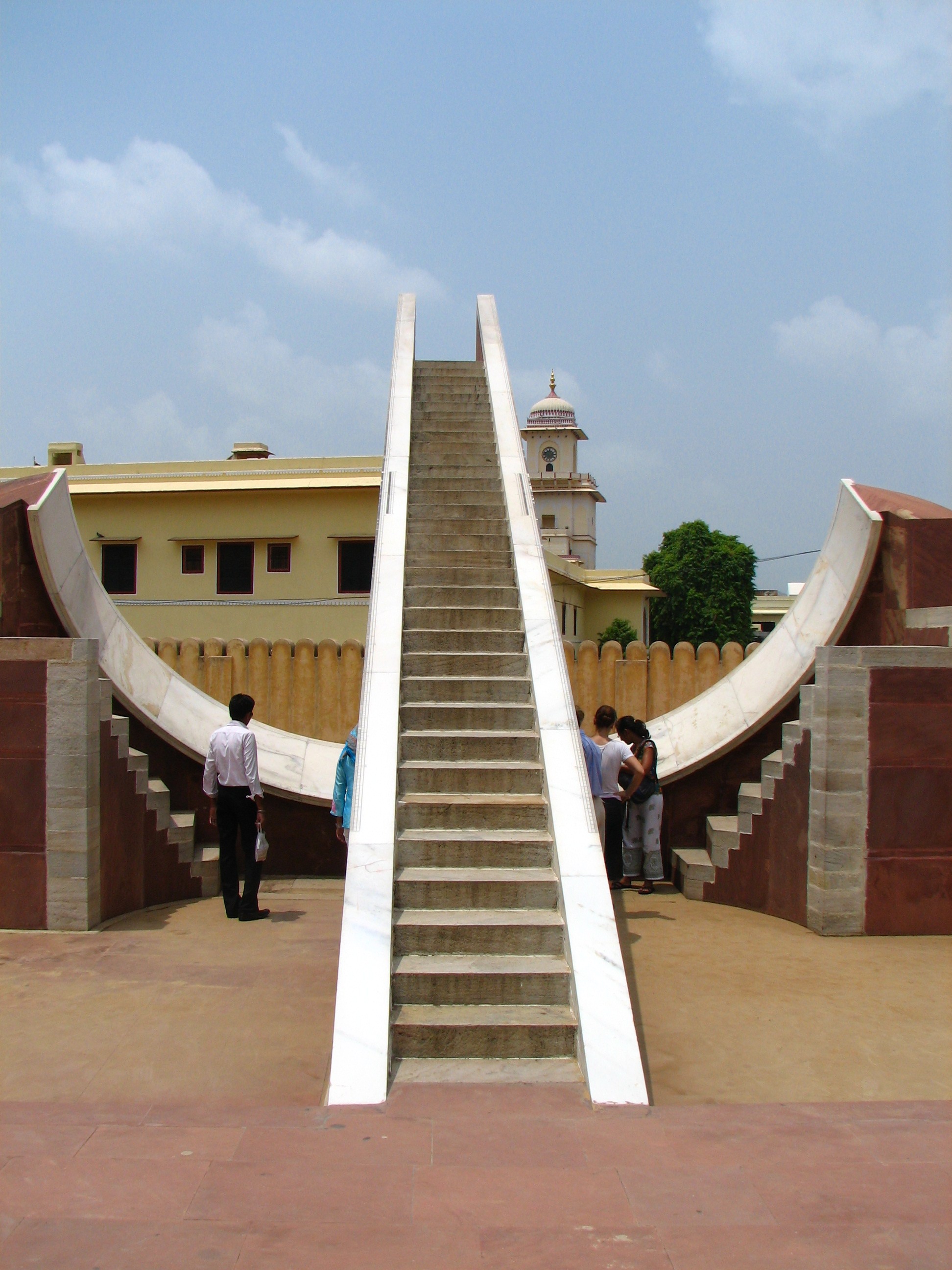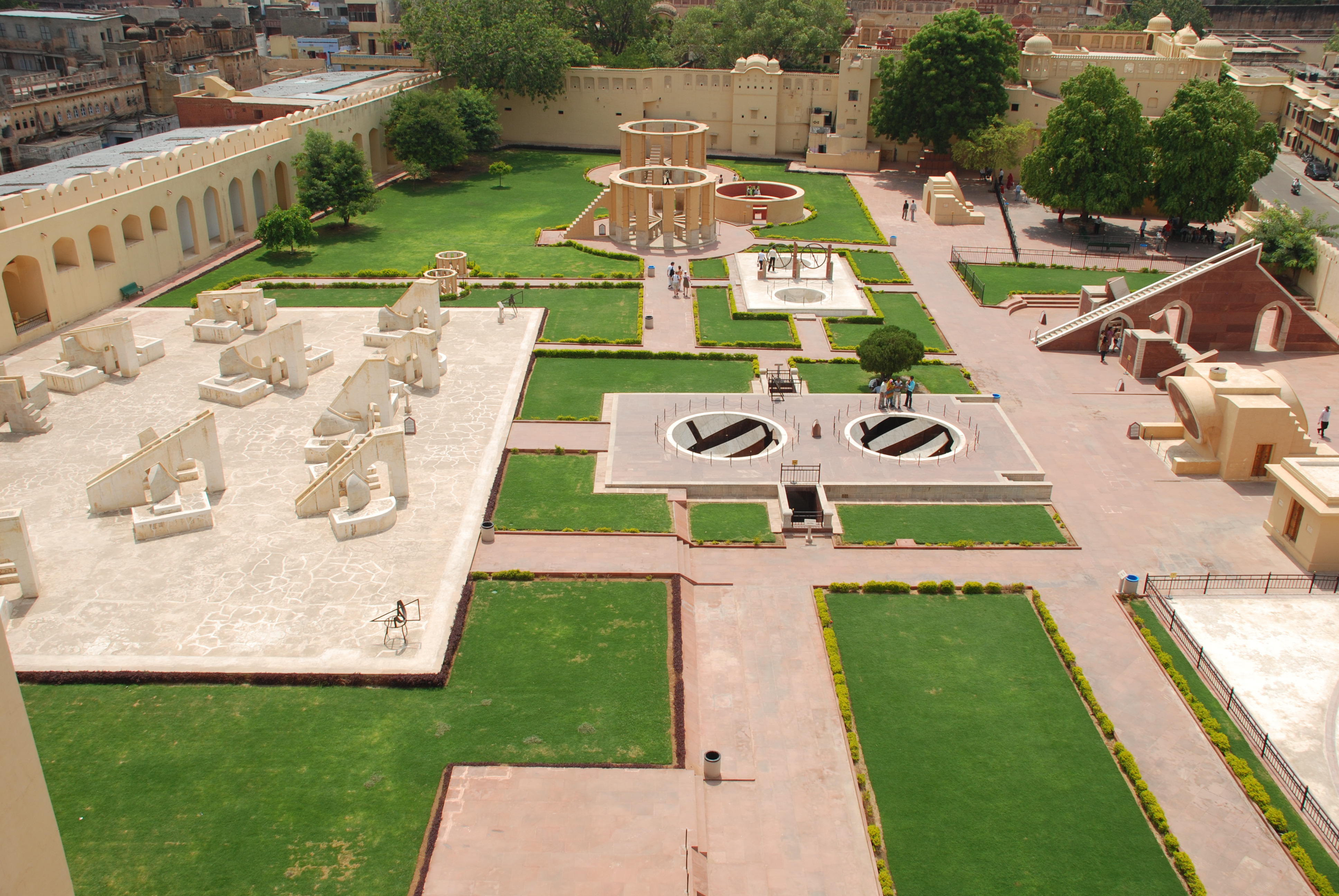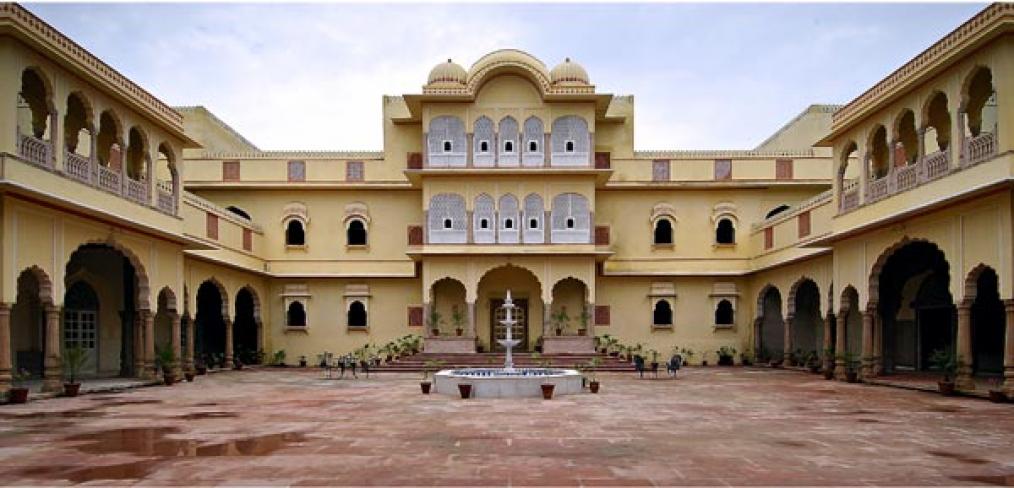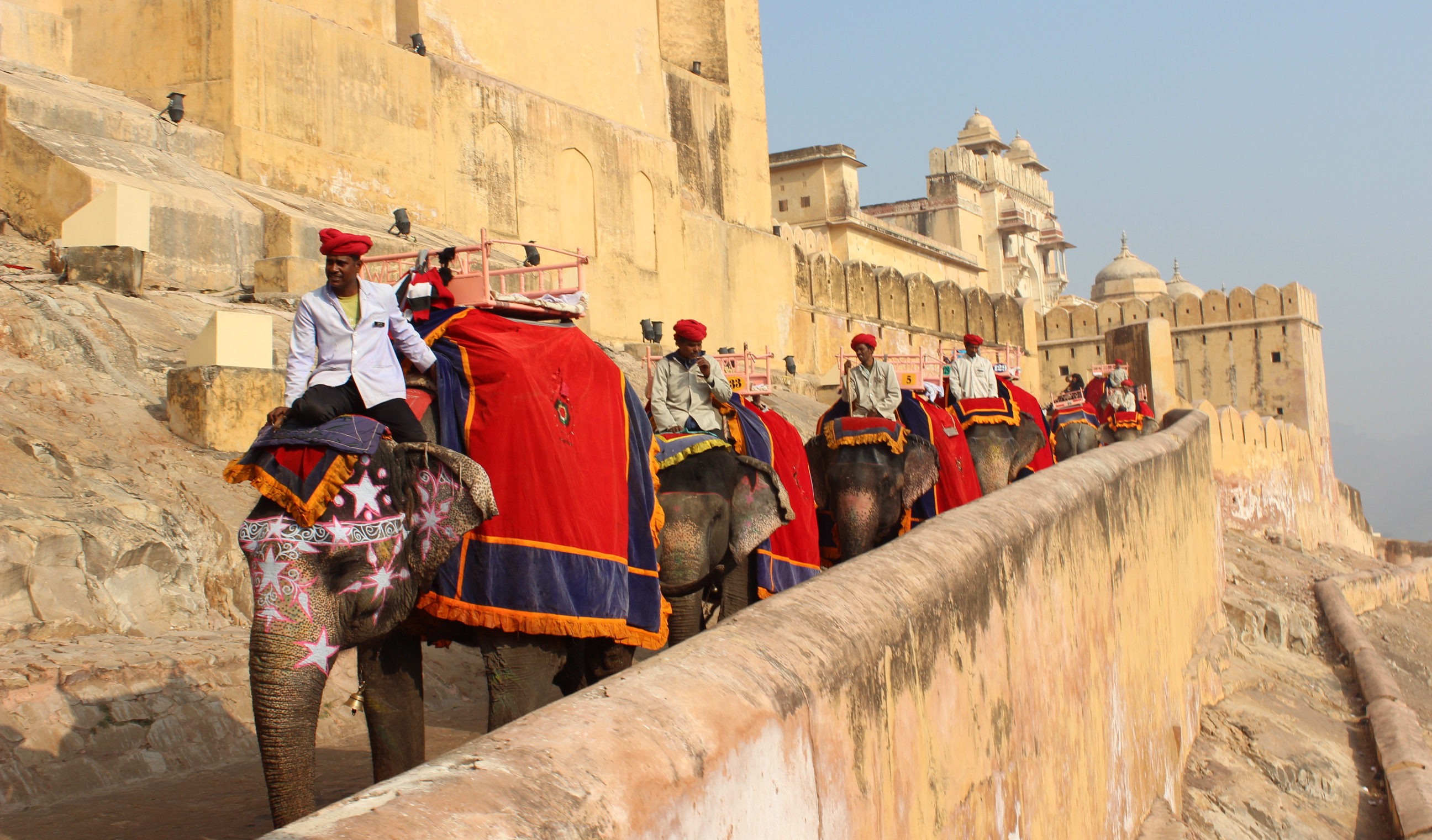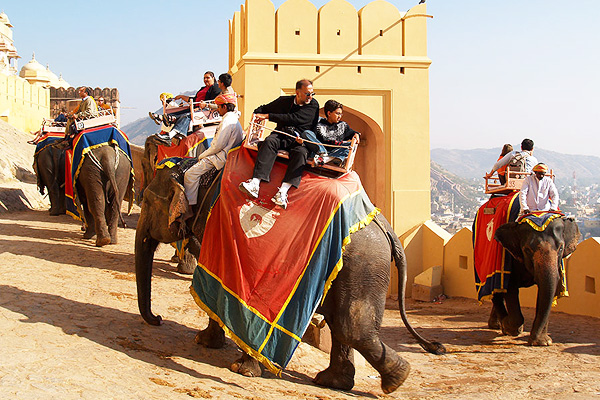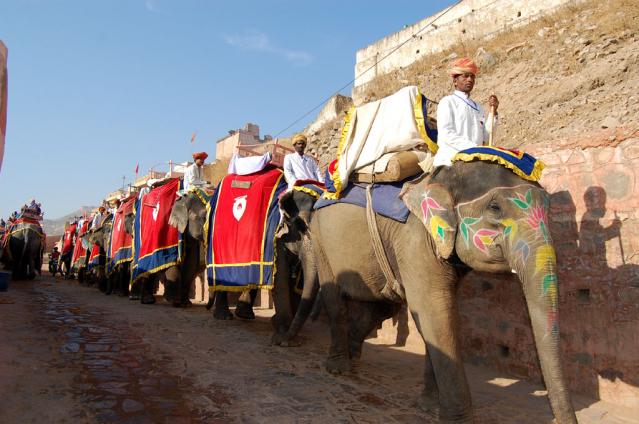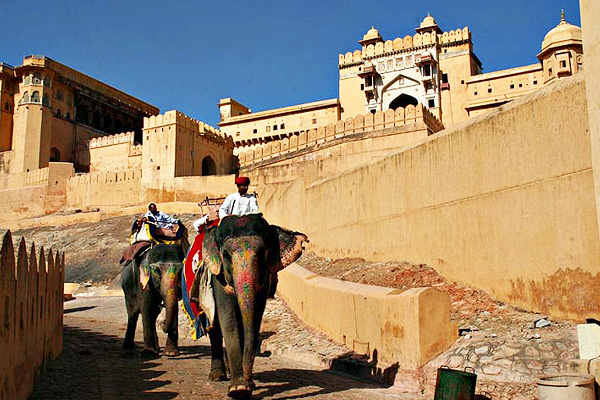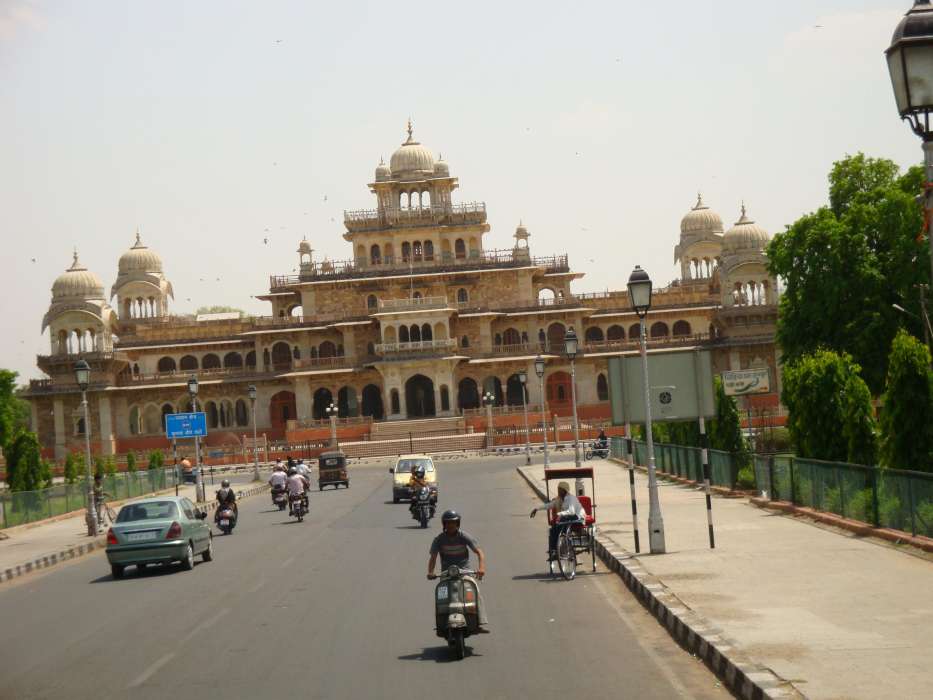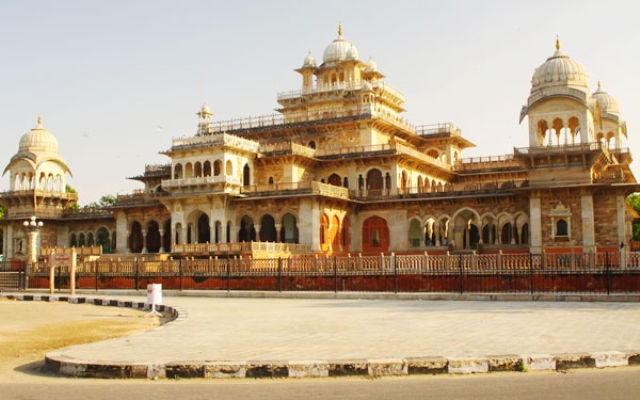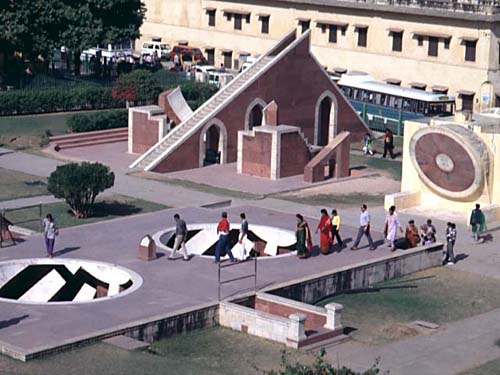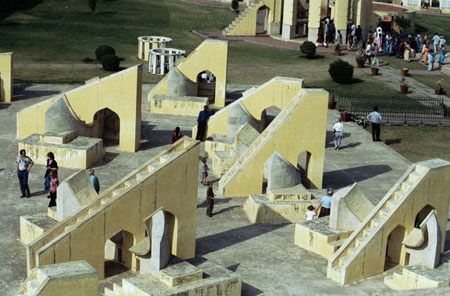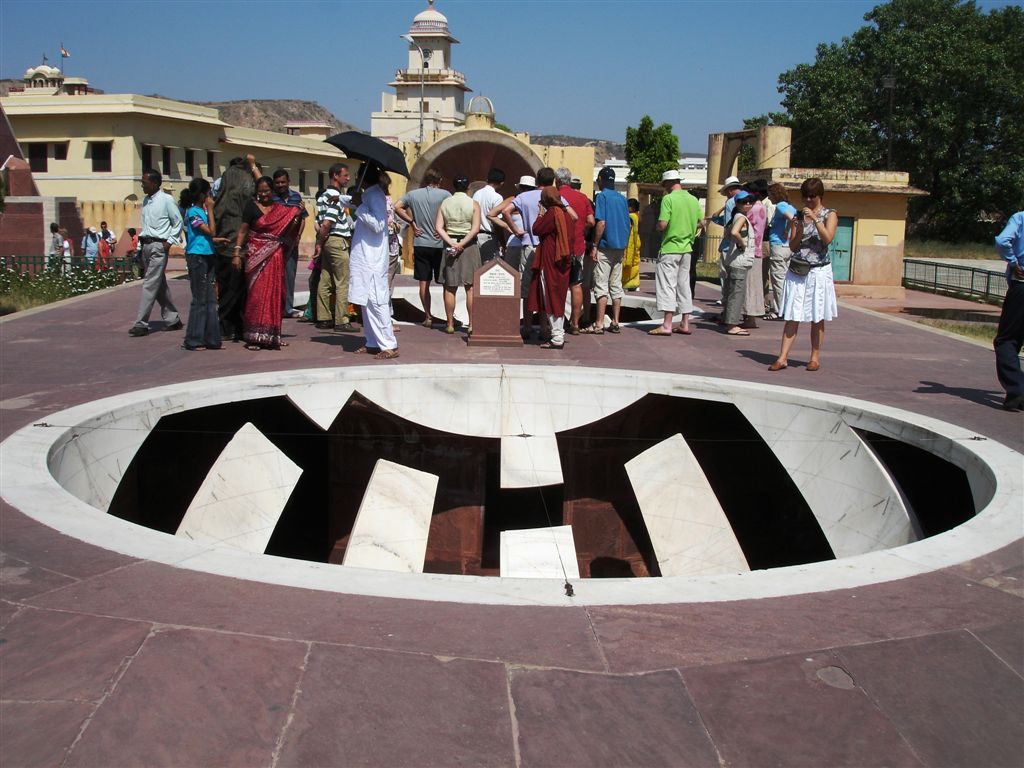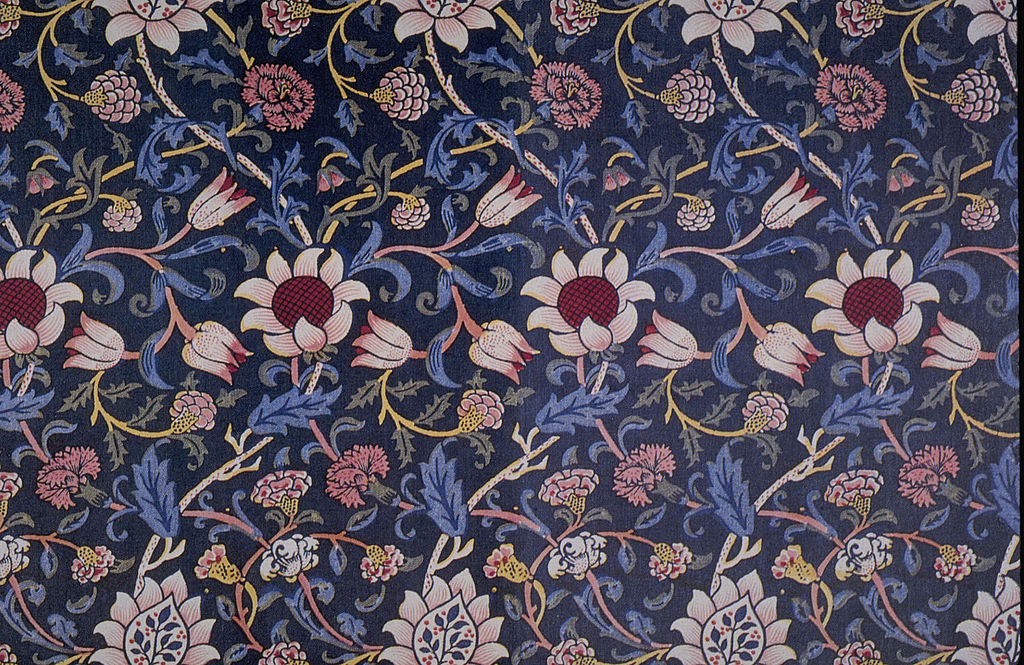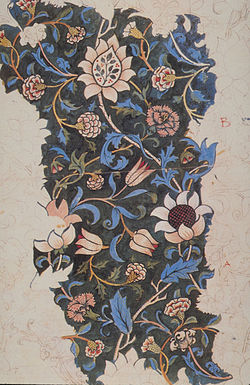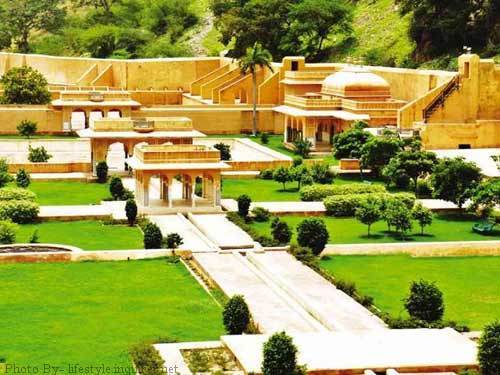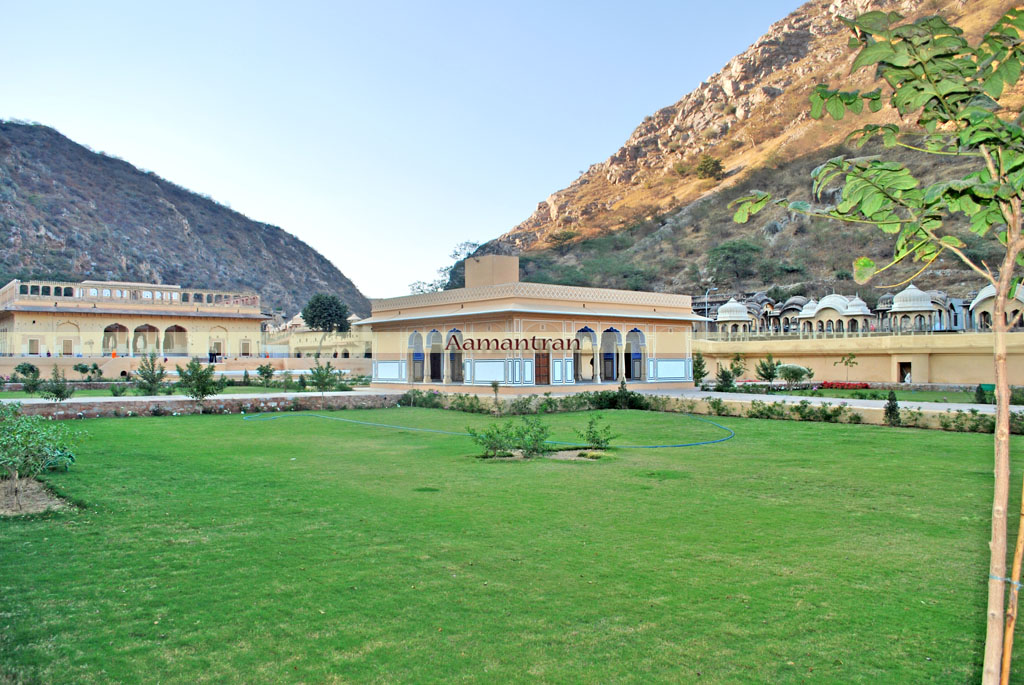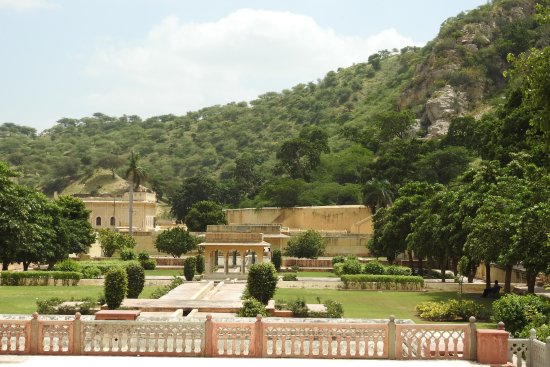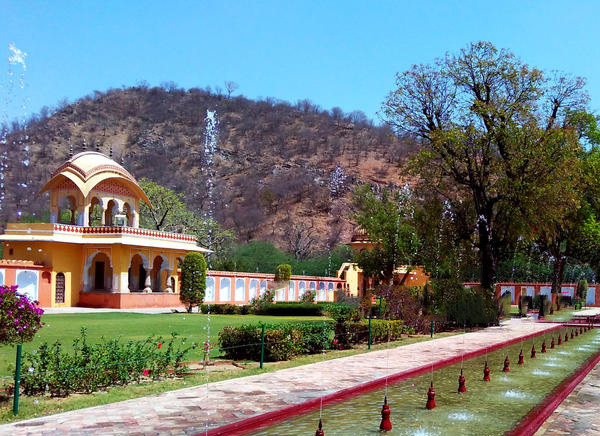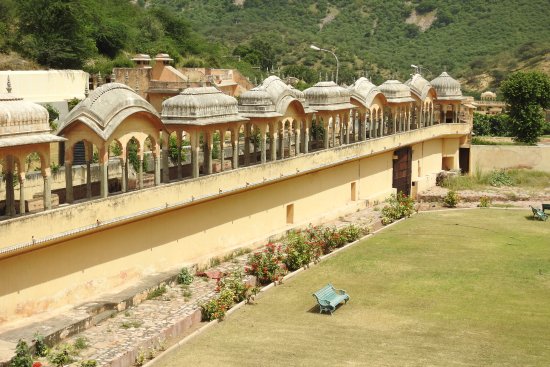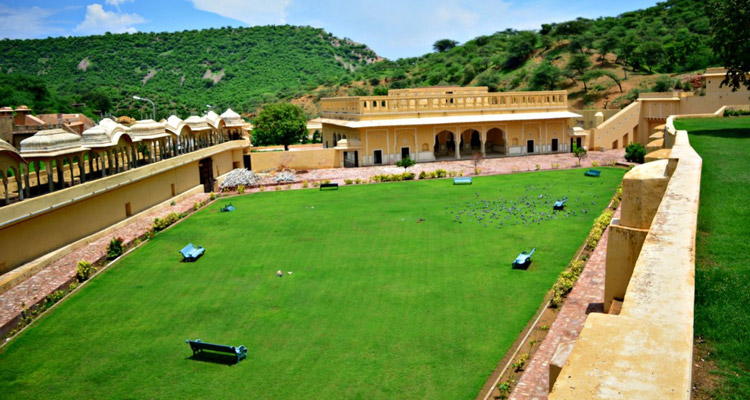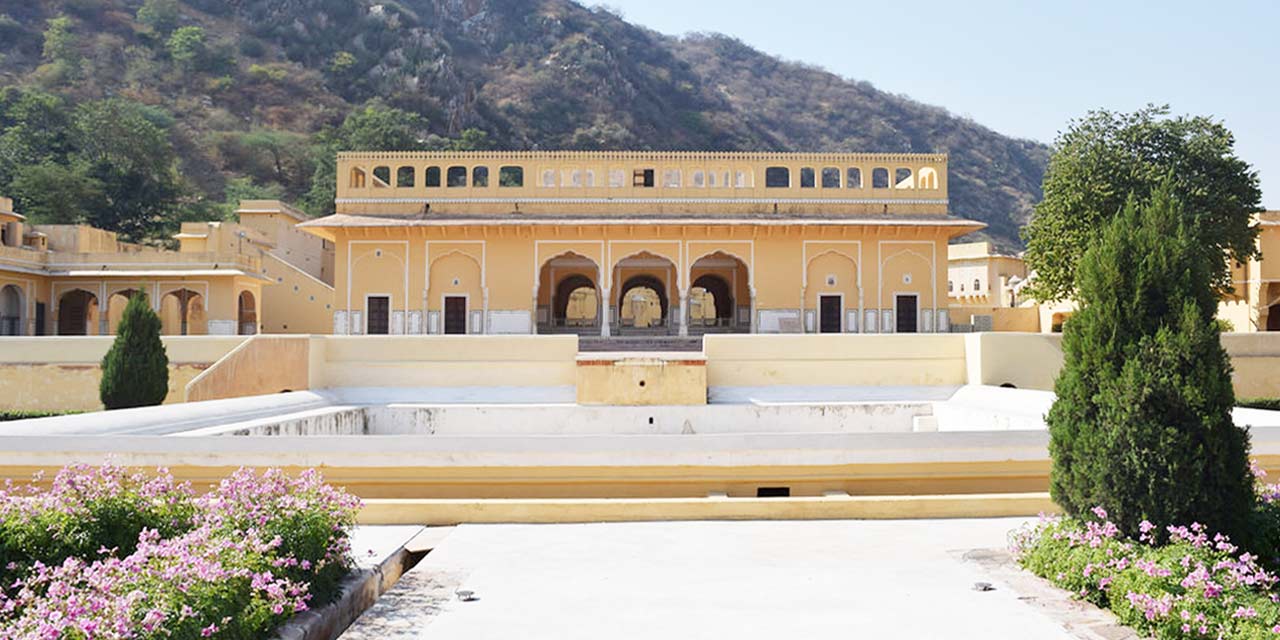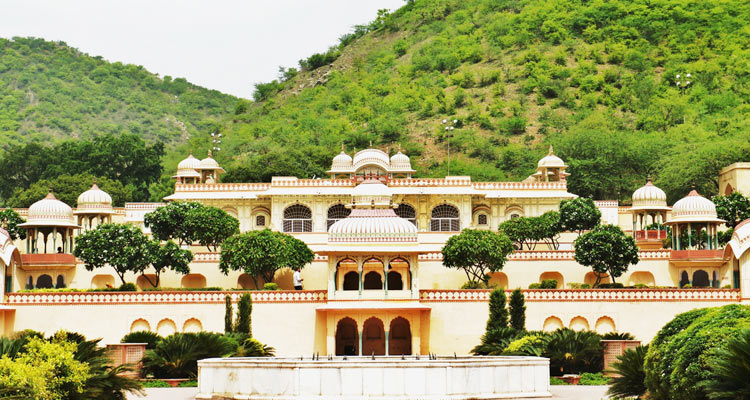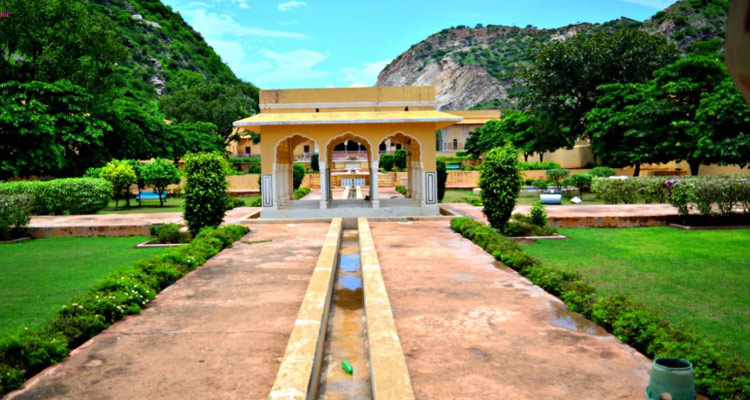齋浦爾, 粉紅城市
一般資訊
区:Jaipur省(州)別:Rajasthan國家:印度面積:64.75 Sq. Km. (Pink City: 9.8 Sq. Km.)使用語言:拉賈斯坦語、印地語、英語長途電話碼:+91-141重要性:粉紅城市與拉賈斯坦邦首府最佳遊覽時間:September 至 March and 9月至3月國際通道:-背景介紹:
勝利之城齋浦爾是由卡恰瓦哈的拉傑普特(Kachhawaha Rajput:Kachhawaha是一支部族,建立統治過幾個王國與土邦,其中最大的就是齋浦爾王國,據說這支部族是太陽神蘇利耶的後裔,Rajput則是指印度種性制度裡面的軍人統治階級的剎帝利)國王傑辛格二世(Jai Singh II)於1727年建立,他在位期間是從1699年到1744年。他對於這座城市的設計、規劃和工程實施特別有興趣,他把這個城市分成九條街,兩條用來建築宮殿與其他公家建築物,剩下的則留給民眾。這個城市由城牆環繞,共有七個城門。
1728年,傑辛格二世修建了天文臺,至今仍是齋浦爾的主要旅遊勝地之一。齋浦爾舊城區有整潔而寬廣的大道,全部粉刷成粉色,因此夜晚的時候為這座城市打上一種魔幻的燈光。齋浦爾擁有多數其他城市所沒有的特色,那就是文化底蘊和建築魅力渾然合為一體,這一點明顯地反映在點綴其中的各個歷史景點上。其中最驚人之作就是哈瓦瑪哈宮(Hawa Mahal),雖然一般普遍認為它是一座風之宮殿,但事實上它卻是一座巨大的沙岩屏風,目的是為了宮中的后妃可以讓她們觀看底下路上的遊行而不被別人看到。齋浦爾以半寶石聞名,購買半寶石的最好去處就是約哈里市場(Johari Bazar)。在齋浦爾還可以買到細密畫、手工藝品、衣服、銀製和紫膠(Lakh/Lac)所製成的珠寶。地點:
齋浦爾這個粉紅城市是拉賈斯坦邦的首府,以城堡、宮殿、湖泊、沙丘和多姿多彩的文化而聞名。這個城市位於北緯26.55度,東經75.52度。如果不是因為阿拉瓦利山(Aravalli)橫亙在齋浦爾的一邊,它就和塔爾沙漠(Thar)接壤,而變成沙漠的一部份了。齋浦爾距離首都德里只有258公里,因此對於遊客來說,就與德里及阿格拉形成了著名的金三角。氣候:
-
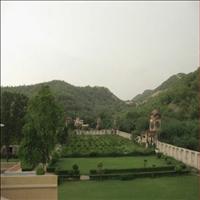 卡納克谷是由阿拉瓦利山脈形成的,並毗鄰琥珀鎮一直延伸到齋浦爾。山上和谷間遍地都是德希克樹(Dhik)和迦曇婆樹(Kadamba:或又譯為迦藤跋樹,是產於東南亞與南亞的一種常綠喬木),越往谷中深處走,你會看到瀑布、蓮花池和滿地開花的植物。夏天時整座森林百花盛開熱情如火,爭奇鬥豔好不美麗。一些候鳥比如尼爾甘茲(Neel kanth)、翠鳥和珠頸斑鳩是這裡的常客。這裡有些歷史已經有300多年的古廟。有一個著名的卡納克花園(Kanak bagh:bagh這種花園通常是具備伊朗回教式的建築風格,園裡有天然的樹木、灌木與花草,再加上人工鋪設的小徑、花床等)和戈溫德夫吉(Govind Dev Ji:克里希納神的另外名字)和納特瓦爾吉神廟(Natwarji),位於達巴瓦提河(Dharbawati)的河岸,過去這條河流曾流經穿越這個城市,但現在則是轉向流入了曼薩加爾湖(Mansagar)。來自各個河流的聖水在此彙集,為舉行阿希瓦梅德亞格納(Ashwamedh Yagna:這是古代的一種祭祀典禮,由國王代表舉行,通常會以馬來作為牲禮)的典禮作準備。
卡納克谷是由阿拉瓦利山脈形成的,並毗鄰琥珀鎮一直延伸到齋浦爾。山上和谷間遍地都是德希克樹(Dhik)和迦曇婆樹(Kadamba:或又譯為迦藤跋樹,是產於東南亞與南亞的一種常綠喬木),越往谷中深處走,你會看到瀑布、蓮花池和滿地開花的植物。夏天時整座森林百花盛開熱情如火,爭奇鬥豔好不美麗。一些候鳥比如尼爾甘茲(Neel kanth)、翠鳥和珠頸斑鳩是這裡的常客。這裡有些歷史已經有300多年的古廟。有一個著名的卡納克花園(Kanak bagh:bagh這種花園通常是具備伊朗回教式的建築風格,園裡有天然的樹木、灌木與花草,再加上人工鋪設的小徑、花床等)和戈溫德夫吉(Govind Dev Ji:克里希納神的另外名字)和納特瓦爾吉神廟(Natwarji),位於達巴瓦提河(Dharbawati)的河岸,過去這條河流曾流經穿越這個城市,但現在則是轉向流入了曼薩加爾湖(Mansagar)。來自各個河流的聖水在此彙集,為舉行阿希瓦梅德亞格納(Ashwamedh Yagna:這是古代的一種祭祀典禮,由國王代表舉行,通常會以馬來作為牲禮)的典禮作準備。薩瓦伊傑辛格差不多是在280年前就把它命名為卡納谷(Kana),那時琥珀是他的首都所在。這個山谷讓他想起了夫林達凡(Vrindavan:古代又稱為Brindavana,是對印度所有宗教都十分重要的聖城,尤其是毗濕奴神教派),於是他就雕塑了克里希納神(Krishna:毗濕奴神的化身),也就是戈溫德夫吉神的神像安置於此。在提吉(Teej:婦女節)和甘葛爾節[Gangaur:拉賈斯坦最重要的節日之一,是由印度女子朝拜濕婆神的妻子葛莉(Gauri),也就是帕瓦蒂女神]的時候,遊行隊伍都會來到此地,賦予了它宗教意義上的重要性。
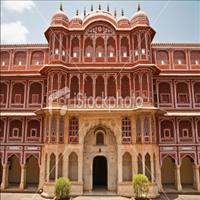 富麗堂皇的城市宮殿位於舊城區的中心,是皇室以前的居住地。該宮完美混合了拉賈斯坦和蒙兀兒的建築風格。灰白大理石柱支撐著精雕細刻的拱門,柱上飾以金色和彩色石花圖案。兩隻大理石造的大象守衛著入口。這座宮殿裡的博物館收集了拉賈斯坦人的服飾,蒙兀兒與拉傑普特的武器,包括各種形狀和尺寸的刀劍,其中一些還帶有鑲嵌寶石的黃金把柄。宮中還有一個藝廊,收藏了種類非常繁多的小型細密畫、地毯、以及用阿拉伯文、波斯文、拉丁文和梵語所寫成的珍稀天文作品,這些都是薩瓦伊傑辛格二世想盡辦法收購而來的。
富麗堂皇的城市宮殿位於舊城區的中心,是皇室以前的居住地。該宮完美混合了拉賈斯坦和蒙兀兒的建築風格。灰白大理石柱支撐著精雕細刻的拱門,柱上飾以金色和彩色石花圖案。兩隻大理石造的大象守衛著入口。這座宮殿裡的博物館收集了拉賈斯坦人的服飾,蒙兀兒與拉傑普特的武器,包括各種形狀和尺寸的刀劍,其中一些還帶有鑲嵌寶石的黃金把柄。宮中還有一個藝廊,收藏了種類非常繁多的小型細密畫、地毯、以及用阿拉伯文、波斯文、拉丁文和梵語所寫成的珍稀天文作品,這些都是薩瓦伊傑辛格二世想盡辦法收購而來的。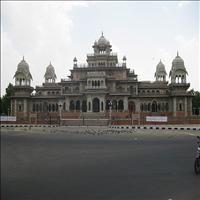 館內有柱子、拱門和飾以壁畫的庭院。博物館或者叫艾伯特廳(Albert Hall)位於拉姆尼瓦斯(Ram Niwas)花園裡。該建築物是在英國軍官斯溫頓.雅各上尉(Swinton Jacob)的帶領下所建立起來的,當時齋浦爾的國王拉姆辛格(Ram singh)想要把它作為市政廳,但繼位者卻把它改建成了齋浦爾市的藝術館。其中有些有趣的展示是關於拉賈斯坦邦的鄉村生活,該博物館還收藏了大量的金屬作品、珠寶、針織品和象牙雕刻,還有飾以浮雕的黃銅器皿;除了雕塑和繪畫之外,該館還收藏不少的陶器製品。
館內有柱子、拱門和飾以壁畫的庭院。博物館或者叫艾伯特廳(Albert Hall)位於拉姆尼瓦斯(Ram Niwas)花園裡。該建築物是在英國軍官斯溫頓.雅各上尉(Swinton Jacob)的帶領下所建立起來的,當時齋浦爾的國王拉姆辛格(Ram singh)想要把它作為市政廳,但繼位者卻把它改建成了齋浦爾市的藝術館。其中有些有趣的展示是關於拉賈斯坦邦的鄉村生活,該博物館還收藏了大量的金屬作品、珠寶、針織品和象牙雕刻,還有飾以浮雕的黃銅器皿;除了雕塑和繪畫之外,該館還收藏不少的陶器製品。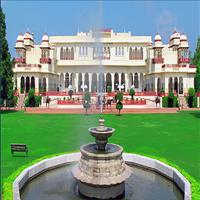 戎巴皇宮現在已經被改建成印度的一個主要遺產旅館。其中的房間保留了皇家風貌,而且周圍全是花草樹木綠意盎然。這個旅館裡面的中國客房和游泳池都很有意思。
戎巴皇宮現在已經被改建成印度的一個主要遺產旅館。其中的房間保留了皇家風貌,而且周圍全是花草樹木綠意盎然。這個旅館裡面的中國客房和游泳池都很有意思。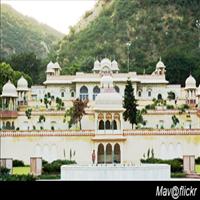 這是薩瓦伊傑辛格於1710年為他的王后所建,距離齋浦爾到阿格拉的公路8公里。裡面有一個三面都有長廊的中央房間,外面還有露臺花園,加上噴泉、池塘和富麗堂皇的雕塑作品,真是錦上添花。離這裡不遠是毗濕奴神、濕婆神和猴神哈努曼神廟。
這是薩瓦伊傑辛格於1710年為他的王后所建,距離齋浦爾到阿格拉的公路8公里。裡面有一個三面都有長廊的中央房間,外面還有露臺花園,加上噴泉、池塘和富麗堂皇的雕塑作品,真是錦上添花。離這裡不遠是毗濕奴神、濕婆神和猴神哈努曼神廟。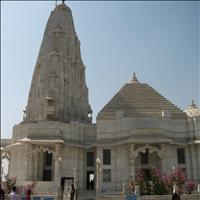 這座寺廟位於莫提登格萊奧爾堡(Moti Dongriort)的山腳下,該堡是伽耶特里皇后(Gayatri Devi:薩瓦曼辛格二世的妻子,齋浦爾王國的皇后,印度獨立廢掉土邦制度之後,也是一位成功的政治人物,更為人津津樂道的是她的長相十分美麗,曾被VOGUE雜誌票選為世界十大美女之一)的一個小別宮。這座白色大理石的神廟是由波拉家族(Birlas)的人所建,共有三個圓頂,意味著皈依三個不同的宗教。
這座寺廟位於莫提登格萊奧爾堡(Moti Dongriort)的山腳下,該堡是伽耶特里皇后(Gayatri Devi:薩瓦曼辛格二世的妻子,齋浦爾王國的皇后,印度獨立廢掉土邦制度之後,也是一位成功的政治人物,更為人津津樂道的是她的長相十分美麗,曾被VOGUE雜誌票選為世界十大美女之一)的一個小別宮。這座白色大理石的神廟是由波拉家族(Birlas)的人所建,共有三個圓頂,意味著皈依三個不同的宗教。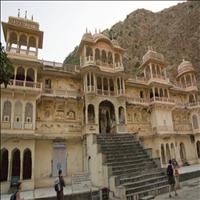 離齋浦爾東部10公里,在前往阿格拉的路上,有一連串亭閣、寺廟和池塘藏在狹谷中。幾百年前一位名叫加爾瓦(Galva)的聖人在此修行。附近山頂上有一座太陽神廟,還有一些天然的溫泉具有醫療功效,是朝聖者紛至遝來的聖地。高塔寺在財務上是由波拉(Birla:印度最富有的家族之一,這個名字幾乎就是財富與權力的象徵)家族所贊助。在這些建築群裡,右邊是寺廟,左邊則可以聽到回蕩的重重鼓聲和鐘聲。這些寺廟後面是稱為康德(Kund)的池塘。
離齋浦爾東部10公里,在前往阿格拉的路上,有一連串亭閣、寺廟和池塘藏在狹谷中。幾百年前一位名叫加爾瓦(Galva)的聖人在此修行。附近山頂上有一座太陽神廟,還有一些天然的溫泉具有醫療功效,是朝聖者紛至遝來的聖地。高塔寺在財務上是由波拉(Birla:印度最富有的家族之一,這個名字幾乎就是財富與權力的象徵)家族所贊助。在這些建築群裡,右邊是寺廟,左邊則可以聽到回蕩的重重鼓聲和鐘聲。這些寺廟後面是稱為康德(Kund)的池塘。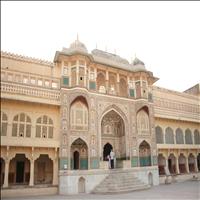 這座城堡是印度教和回教建築的迷人混合體,由曼辛格國王(Raja Mansingh)在16世紀時建在山邊。工程是由國王曼辛格一世(Mansingh I)在1592年開始,而後由他的後代傑辛格一世(Jai singh I)完成。雖然城堡的外表崎嶇不平,而內部卻美麗無比,印度教和回教建築風格融合得巧奪天工,渾然天成。牆壁繪著狩獵和戰爭的畫面,還零星點綴著鑲嵌在石灰泥牆上的寶石與鏡子。城堡的前方廣場有一座瑪奧塔湖(Maota Lake),剛好映襯著這座富麗堂皇城堡的倒影。
這座城堡是印度教和回教建築的迷人混合體,由曼辛格國王(Raja Mansingh)在16世紀時建在山邊。工程是由國王曼辛格一世(Mansingh I)在1592年開始,而後由他的後代傑辛格一世(Jai singh I)完成。雖然城堡的外表崎嶇不平,而內部卻美麗無比,印度教和回教建築風格融合得巧奪天工,渾然天成。牆壁繪著狩獵和戰爭的畫面,還零星點綴著鑲嵌在石灰泥牆上的寶石與鏡子。城堡的前方廣場有一座瑪奧塔湖(Maota Lake),剛好映襯著這座富麗堂皇城堡的倒影。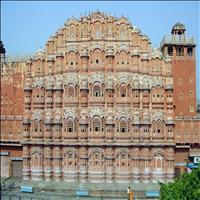 哈瓦瑪哈宮是這個城市最最重要的地標。這座嵌滿蜂巢般窗戶的宮殿被叫做「風之宮殿」,最初的目的是為了讓王室的女眷可以不用抛頭露面,而能觀看日常人民的生活,以及在這座紅粉城市所舉辦的遊行。這個非凡的建築傑作是由薩瓦伊普拉塔普辛格(Sawai Pratap singh)於1799年建立的,這個建築從外面看起來像克里希納神(Krishna)頭上的王冠(又叫穆庫特mukut),因為薩瓦伊普拉塔普辛格是克里希納神的信徒,而這棟建築就是他為克里希納神所建的。這個建築俯瞰著下面的一條主要大街,和城市宮殿的外牆相接,被外牆與其他比較平淡無奇的建築群夾在中間。
哈瓦瑪哈宮是這個城市最最重要的地標。這座嵌滿蜂巢般窗戶的宮殿被叫做「風之宮殿」,最初的目的是為了讓王室的女眷可以不用抛頭露面,而能觀看日常人民的生活,以及在這座紅粉城市所舉辦的遊行。這個非凡的建築傑作是由薩瓦伊普拉塔普辛格(Sawai Pratap singh)於1799年建立的,這個建築從外面看起來像克里希納神(Krishna)頭上的王冠(又叫穆庫特mukut),因為薩瓦伊普拉塔普辛格是克里希納神的信徒,而這棟建築就是他為克里希納神所建的。這個建築俯瞰著下面的一條主要大街,和城市宮殿的外牆相接,被外牆與其他比較平淡無奇的建築群夾在中間。這座五層高如金字塔形狀的建築由小型的對外平開窗所組成,每扇窗上方都有懸空的拱型飛簷,精雕細刻,繁複華麗。整個建築看起來更像是一扇屏風,而不是一座宮殿。最高的三層都是單獨的房間,但下面卻是兩個庭院;這是一座50英尺高,厚度不到一英尺的隔屏。鏤空的紅沙石窗格和圓頂使得這個宮殿的正面看起來獨特無比。日出的時候,風之宮沐浴在金色的陽光中像璀璨的寶石,真是最值得觀賞的時刻。
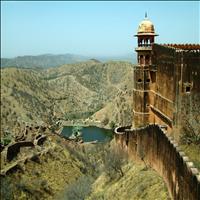 傑加爾堡的意思是勝利之堡。這棟崎嶇粗獷的城堡是由薩瓦伊傑辛格[Sawai Jaisingh:琥珀國(Amber)之國王,當時是蒙兀兒帝國奧朗澤布(Aurengzeb)在位時]於西元1725年建立,好幾年一直都是皇家的寶庫。這個城堡矗立在懸崖之上,周邊是巨大的城垛而裡面是走道,可以讓你欣賞全方位的美景。世界上最大的舊式車輪大炮-傑凡(Jaivan)就在這裡,它的炮管有20英尺長,而車輪的直徑有9英尺。
傑加爾堡的意思是勝利之堡。這棟崎嶇粗獷的城堡是由薩瓦伊傑辛格[Sawai Jaisingh:琥珀國(Amber)之國王,當時是蒙兀兒帝國奧朗澤布(Aurengzeb)在位時]於西元1725年建立,好幾年一直都是皇家的寶庫。這個城堡矗立在懸崖之上,周邊是巨大的城垛而裡面是走道,可以讓你欣賞全方位的美景。世界上最大的舊式車輪大炮-傑凡(Jaivan)就在這裡,它的炮管有20英尺長,而車輪的直徑有9英尺。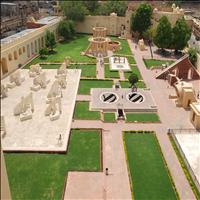 薩瓦伊傑辛格國王在18世紀所建立的五座天文臺當中,姜塔曼塔是最著名的一個。他思想很先進並且篤信科技,對於天文學更是充滿熱情。姜塔曼塔位於城市宮殿的大門附近,是世界上最大的石製天文臺,並且關於它的建造過程,背後還有一個有趣的故事。在開始建造之前,薩瓦伊傑辛格曾派他的使者周遊世界各地,他們帶回來許多含有技術資訊的天文學手冊;其中之一就是拉海爾刻度盤(Philippe de La Hire:一位法國的數學家兼天文學家,刻度盤是計算太陽、月亮及其它行星的運轉),國王便要求按照這些刻度盤來造這座天文臺。竣工後他們才發現到天文臺要比這些刻度盤還要精確20秒。
薩瓦伊傑辛格國王在18世紀所建立的五座天文臺當中,姜塔曼塔是最著名的一個。他思想很先進並且篤信科技,對於天文學更是充滿熱情。姜塔曼塔位於城市宮殿的大門附近,是世界上最大的石製天文臺,並且關於它的建造過程,背後還有一個有趣的故事。在開始建造之前,薩瓦伊傑辛格曾派他的使者周遊世界各地,他們帶回來許多含有技術資訊的天文學手冊;其中之一就是拉海爾刻度盤(Philippe de La Hire:一位法國的數學家兼天文學家,刻度盤是計算太陽、月亮及其它行星的運轉),國王便要求按照這些刻度盤來造這座天文臺。竣工後他們才發現到天文臺要比這些刻度盤還要精確20秒。 納哈加爾堡[老虎堡](Nahargarh Fort-Tiger Fort)](https://www.t2india.com/Images/Places/JAI/attractions/AX2_0.jpeg) 納哈加爾堡身為粉紅城市齊浦爾的前哨站,座落在納哈加爾山上,高度距離地面的齋浦爾市約600英尺。這個堡也被叫做蘇達爾桑加爾(Sudarshangarh:sudarshan chakra是指毗濕奴神手上的鐵盤象徵宇宙或太陽,garh指城堡),位於齋浦爾這座城市宮殿西北邊6公里之處,居高臨下可以俯瞰整個城市的美景。它是由傑辛格二世於西元1734年為防衛這座城市而建,這是齋浦爾歷代國王所建的三座城堡中的第一座。關於這個城堡有著很多傳奇故事,而且每位統治者都在城堡內有所增建,從而留下了自己的印記。湖中央有個富麗堂皇的檯子是供古代王公貴族舉行獵鴨比賽時藏身所用(duck blind:獵鴨時用來藏身不讓動物察覺的遮避物)。那兒還有一個國王皇后專用的行館,好幾年都被用作私人收藏的寶庫。
納哈加爾堡身為粉紅城市齊浦爾的前哨站,座落在納哈加爾山上,高度距離地面的齋浦爾市約600英尺。這個堡也被叫做蘇達爾桑加爾(Sudarshangarh:sudarshan chakra是指毗濕奴神手上的鐵盤象徵宇宙或太陽,garh指城堡),位於齋浦爾這座城市宮殿西北邊6公里之處,居高臨下可以俯瞰整個城市的美景。它是由傑辛格二世於西元1734年為防衛這座城市而建,這是齋浦爾歷代國王所建的三座城堡中的第一座。關於這個城堡有著很多傳奇故事,而且每位統治者都在城堡內有所增建,從而留下了自己的印記。湖中央有個富麗堂皇的檯子是供古代王公貴族舉行獵鴨比賽時藏身所用(duck blind:獵鴨時用來藏身不讓動物察覺的遮避物)。那兒還有一個國王皇后專用的行館,好幾年都被用作私人收藏的寶庫。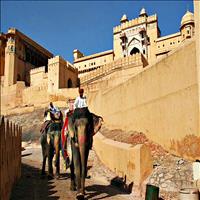 Elephant Ride at Amer Fort
Elephant Ride at Amer Fort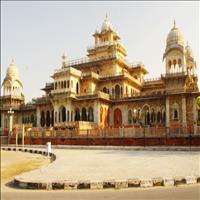 When the foundation stone of Albert Hall was laid during the visit of the Prince of Wales, Albert Edward to Jaipur in 1876, it had yet to be determined what use it would be put to. There were some suggestions about cultural or educational use or as a town hall. However in 1880 Maharaja Sawai Madho Singh II approved a suggestion by Dr. Thomas Holbein Hendley, Resident Surgeon (whose interests extended beyond his medical responsibilities) to open a museum of Industrial Arts to display products of local craftsmen. A small museum was created in 1881 in temporary accommodation and proved most popular. Additionally, Hendley in 1883 mounted a Jaipur Exhibition at Naya Mahal (old Vidhan Sabha). The purpose of these exercises was to acquaint local craftsmen with the best examples of art work and handicrafts of India to inspire them to improve their skills, thereby protecting and preserving traditional art and reviving skills, while providing greater employment for artisans. It was also the intention that the display would help to educate youth in a wide variety of fields, entertain and inform the people of Jaipur.
When the foundation stone of Albert Hall was laid during the visit of the Prince of Wales, Albert Edward to Jaipur in 1876, it had yet to be determined what use it would be put to. There were some suggestions about cultural or educational use or as a town hall. However in 1880 Maharaja Sawai Madho Singh II approved a suggestion by Dr. Thomas Holbein Hendley, Resident Surgeon (whose interests extended beyond his medical responsibilities) to open a museum of Industrial Arts to display products of local craftsmen. A small museum was created in 1881 in temporary accommodation and proved most popular. Additionally, Hendley in 1883 mounted a Jaipur Exhibition at Naya Mahal (old Vidhan Sabha). The purpose of these exercises was to acquaint local craftsmen with the best examples of art work and handicrafts of India to inspire them to improve their skills, thereby protecting and preserving traditional art and reviving skills, while providing greater employment for artisans. It was also the intention that the display would help to educate youth in a wide variety of fields, entertain and inform the people of Jaipur.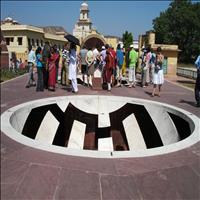 There are plenty of observatories all over the world, but the Jantar Mantar is considered to be one of the largest observatories ever built. Combining religion, science and art, the Jantar Mantar is the name given to a series of five, magnificent structures built in Jaipur, New Delhi, Ujjan, Varanasi and Mathura. Jaipur was the seat of Maharaja Jai Singh II during the 1720's and this is when this magnificent structure was built here. The Jantar Mantar in Jaipur is considered to be the largest of the five observatories and also houses the world's largest sundial. The Universe and the Cosmos have always been of interest to man, and it was this interest that compelled the Maharaja to build an astronomical observatory. The term 'Jantar Mantar' is derived from the Sanskrit terms 'Yantra' and 'Mantra' meaning 'instruments' and 'formula' respectively. The term 'Yantra' was replaced with 'Jantar' which means 'magical'. The Jantar Mantar houses various architectural and astrological instruments that have caught the interests of astronomers, historians and architects around the world.
There are plenty of observatories all over the world, but the Jantar Mantar is considered to be one of the largest observatories ever built. Combining religion, science and art, the Jantar Mantar is the name given to a series of five, magnificent structures built in Jaipur, New Delhi, Ujjan, Varanasi and Mathura. Jaipur was the seat of Maharaja Jai Singh II during the 1720's and this is when this magnificent structure was built here. The Jantar Mantar in Jaipur is considered to be the largest of the five observatories and also houses the world's largest sundial. The Universe and the Cosmos have always been of interest to man, and it was this interest that compelled the Maharaja to build an astronomical observatory. The term 'Jantar Mantar' is derived from the Sanskrit terms 'Yantra' and 'Mantra' meaning 'instruments' and 'formula' respectively. The term 'Yantra' was replaced with 'Jantar' which means 'magical'. The Jantar Mantar houses various architectural and astrological instruments that have caught the interests of astronomers, historians and architects around the world.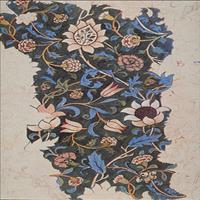 Sanganer is a town situated 16 km south of Jaipur, the capital of Indian state of Rajasthan. It is famous for textile printing, handmade paper industry, and for Jain temples. Sanganer prints are one of its own kinds, for the reason that patterns in bright colours are always printed on white backgrounds.
Textile printing is the process of applying colour to fabric in definite patterns or designs. In properly printed fabrics the colour is bonded with the fibre, so as to resist washing and friction. Textile printing is related to dyeing but in dyeing properly the whole fabric is uniformly covered with one colour, whereas in printing one or more colours are applied to it in certain parts only, and in sharply defined patterns.
In printing, wooden blocks, stencils, engraved plates, rollers, or silkscreens can be used to place colours on the fabric. Colourants used in printing contain dyes thickened to prevent the colour from spreading by capillary attraction beyond the limits of the pattern or design.
The art, science, and technology of papermaking addresses the methods, equipment, and materials used to make paper and cardboard, these being used widely for printing, writing, and packaging, among many other purposes and useful products. Today almost all paper is manufactured using industrial machinery, while handmade paper survives as a specialized craft and a medium for artistic expression.
In papermaking, a dilute suspension consisting mostly of separate cellulose fibres in water is drained through a sieve-like screen, so that a mat of randomly interwoven fibres is laid down. Water is further removed from this sheet by pressing, sometimes aided by suction or vacuum, or heating. Once dry, a generally flat, uniform and strong sheet of paper is achieved.
Before the invention and current widespread adoption of automated machinery, all paper was made by hand, formed or laid one sheet at a time by specialized laborers. Even today those who make paper by hand use tools and technologies quite similar to those existing hundreds of years ago, as originally developed in China and Asia, or those further modified in Europe. Handmade paper is still appreciated for its distinctive uniqueness and the skilled craft involved in making each sheet, in contrast with the higher degree of uniformity and perfection at lower prices achieved among industrial products.
Sanganer is a famous pilgrimage town for the Jain community because of a very ancient Jain temple made of red stone. The ancient Shri Digamber Jain temple of Sanganer is 16 km from Jaipur. In this temple the principal deity is the Lord Adinath (Rishabh Dev); The ancient Shri Digambara Jain temple of Sanganer has fine carvings that are comparable to the Dilwara Temples of Mount Abu that are built in many phases. The last phase of this temple was completed in the 10th century A.D., according to inscription of V.S. 1011 in one of the Toranas. It has sky-high shikharas and the inner sanctum is a stone shrine with sky-high eight shikharas (pinnacles).
In the midst of underground portion, there is located an ancient small temple guarded by the Yaksha. The sacred temple has seven underground floors which are kept closed due to old religious beliefs and visitors are not allowed to see them. It is said[by whom?] that only a Balyati ascetic Digambara saint can enter in it and able to bring out the idols of this underground temple for a limited period, which is declared and decided previously. The idols thus brought out for viewing (Darshan) of devotees, must be placed back within auspicious signs. The temple came in light when Muni Sudhasagar Ji, a disciple of Acharya Vidyasagar Ji visited the underground floors. He brought valuable, never seen before, Jain Murti made of precious stones from the underground floors in the presence of more than five lac Jain disciples.
Sanganer is a town situated 16 km south of Jaipur, the capital of Indian state of Rajasthan. It is famous for textile printing, handmade paper industry, and for Jain temples. Sanganer prints are one of its own kinds, for the reason that patterns in bright colours are always printed on white backgrounds.
Textile printing is the process of applying colour to fabric in definite patterns or designs. In properly printed fabrics the colour is bonded with the fibre, so as to resist washing and friction. Textile printing is related to dyeing but in dyeing properly the whole fabric is uniformly covered with one colour, whereas in printing one or more colours are applied to it in certain parts only, and in sharply defined patterns.
In printing, wooden blocks, stencils, engraved plates, rollers, or silkscreens can be used to place colours on the fabric. Colourants used in printing contain dyes thickened to prevent the colour from spreading by capillary attraction beyond the limits of the pattern or design.
The art, science, and technology of papermaking addresses the methods, equipment, and materials used to make paper and cardboard, these being used widely for printing, writing, and packaging, among many other purposes and useful products. Today almost all paper is manufactured using industrial machinery, while handmade paper survives as a specialized craft and a medium for artistic expression.
In papermaking, a dilute suspension consisting mostly of separate cellulose fibres in water is drained through a sieve-like screen, so that a mat of randomly interwoven fibres is laid down. Water is further removed from this sheet by pressing, sometimes aided by suction or vacuum, or heating. Once dry, a generally flat, uniform and strong sheet of paper is achieved.
Before the invention and current widespread adoption of automated machinery, all paper was made by hand, formed or laid one sheet at a time by specialized laborers. Even today those who make paper by hand use tools and technologies quite similar to those existing hundreds of years ago, as originally developed in China and Asia, or those further modified in Europe. Handmade paper is still appreciated for its distinctive uniqueness and the skilled craft involved in making each sheet, in contrast with the higher degree of uniformity and perfection at lower prices achieved among industrial products.
Sanganer is a famous pilgrimage town for the Jain community because of a very ancient Jain temple made of red stone. The ancient Shri Digamber Jain temple of Sanganer is 16 km from Jaipur. In this temple the principal deity is the Lord Adinath (Rishabh Dev); The ancient Shri Digambara Jain temple of Sanganer has fine carvings that are comparable to the Dilwara Temples of Mount Abu that are built in many phases. The last phase of this temple was completed in the 10th century A.D., according to inscription of V.S. 1011 in one of the Toranas. It has sky-high shikharas and the inner sanctum is a stone shrine with sky-high eight shikharas (pinnacles).
In the midst of underground portion, there is located an ancient small temple guarded by the Yaksha. The sacred temple has seven underground floors which are kept closed due to old religious beliefs and visitors are not allowed to see them. It is said[by whom?] that only a Balyati ascetic Digambara saint can enter in it and able to bring out the idols of this underground temple for a limited period, which is declared and decided previously. The idols thus brought out for viewing (Darshan) of devotees, must be placed back within auspicious signs. The temple came in light when Muni Sudhasagar Ji, a disciple of Acharya Vidyasagar Ji visited the underground floors. He brought valuable, never seen before, Jain Murti made of precious stones from the underground floors in the presence of more than five lac Jain disciples.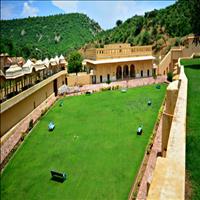 The Vidyadhar garden is a pristine garden located in the heart of Jaipur. One of Jaipur's best-preserved gardens, this picturesque garden is aesthetically designed and was built in the memory of Jaipur's chief Architect, Vidyadhar Bhattacharya. Apart from the crystal waters, the tranquil lakes, flower beds and well-maintained gardens, the Vidyadhar Garden has a lot to offer. Nestled in the lap of a popular valley in Jaipur, the garden offers a panoramic view of the city and is the pride of Jaipur's heavy heritage and culture. The garden was strategically built to the decrees of the ancient 'Shilpa Shasthra' and is situated close to the Sisodia gardens. The garden is the perfect amalgamation of contemporary Hindu and Mughal styles with its wonderful, sylvan lakes, terraced lawns, fountains and the majestic pavilions that house Lord Krishna's murals and paintings. Managed by the Government of Rajasthan, the Vidyadhar Garden is a vast expanse of imperial architecture and dazzling greenery.
The Vidyadhar garden is a pristine garden located in the heart of Jaipur. One of Jaipur's best-preserved gardens, this picturesque garden is aesthetically designed and was built in the memory of Jaipur's chief Architect, Vidyadhar Bhattacharya. Apart from the crystal waters, the tranquil lakes, flower beds and well-maintained gardens, the Vidyadhar Garden has a lot to offer. Nestled in the lap of a popular valley in Jaipur, the garden offers a panoramic view of the city and is the pride of Jaipur's heavy heritage and culture. The garden was strategically built to the decrees of the ancient 'Shilpa Shasthra' and is situated close to the Sisodia gardens. The garden is the perfect amalgamation of contemporary Hindu and Mughal styles with its wonderful, sylvan lakes, terraced lawns, fountains and the majestic pavilions that house Lord Krishna's murals and paintings. Managed by the Government of Rajasthan, the Vidyadhar Garden is a vast expanse of imperial architecture and dazzling greenery.